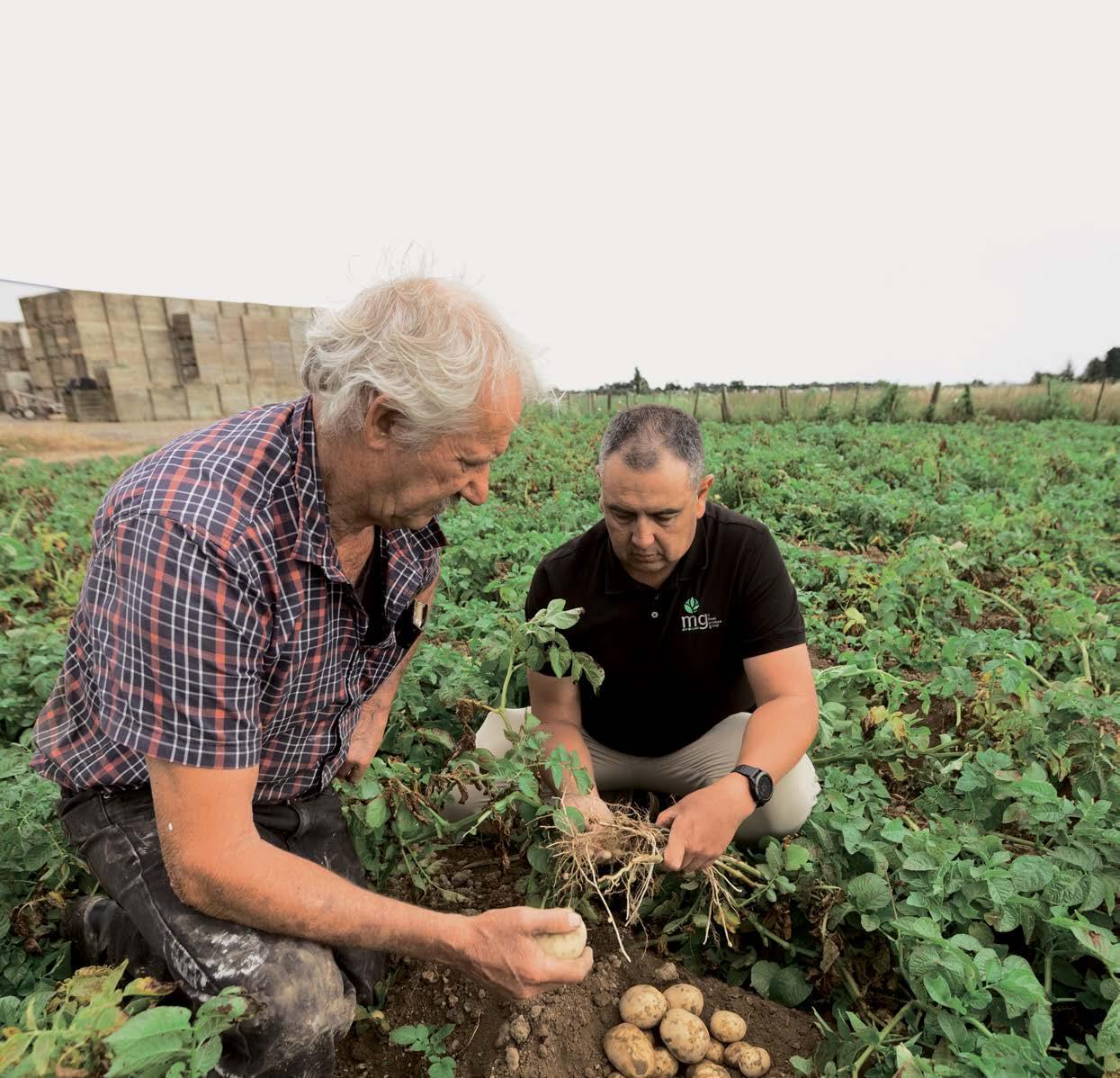

AN ASA-‘LIFT’ GIVE YOUR PRODUCTION
When
it comes to harvesting, ASA-LIFT brings you innovative, specialised crop solutions to drive production further.


Since 1936 ASA-LIFT has built a solid reputation for quality, innovation and constant evolution to meet market demands. Maximise your harvest with an ASA-LIFT mounted, trailed or self propelled vegetable harvester - now proudly available from LANDPOWER Vegetable Centre.



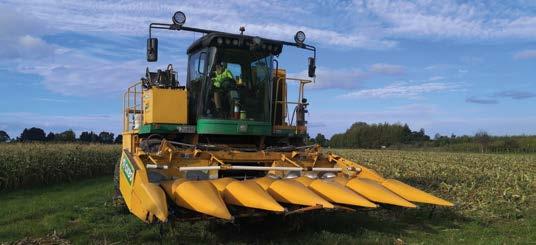




NATIONAL POLICY ADVOCACY HAS ITS CHALLENGES
Barry O’Neil : HortNZ presidentas Federated Farmers, so that we can have joint positions and also share the workload, when possible.
It’s interesting that, depending what lens we wear, fruit groups often think we are too focused on vegetable issues, and vegetable groups see us as too focused on fruit groups. Well maybe we have the balance right then! But to me with the policy issues common to both, this becomes an academic argument.
We all need the ability to use suitable land for growing, to use the inputs needed such as water, the ability to spray and use fertiliser. We all need adequate and affordable labour to plant and harvest. And we all need to maintain our social licence to operate.
Our advocacy is science-based and we want any new government policy to be aligned and integrated rather than disconnected.
HortNZ’s strategy is focused on proactively influencing policy at a national and regional level – seeking the best operating conditions for horticulture in areas such as the environment, biosecurity, food safety, crop protection and labour. We also focus on translating sector wide policy changes for growers so they are familiar with newly implemented policy and regulations and know what is needed in order to comply.
The reality however is that over 90 percent of national policy issues are common to all of horticulture, and all growers want and need the best outcome we can achieve. We don’t and won’t always get everything we argue for, and we are not able to push back the tide. Nor should we if policy changes are needed for future generations to succeed, and also expected by our consumers. And of course the government is setting national policy for all of the food and fibre sector, and is not favouring horticulture over pastoral farming. As you would expect, the other sectors’ industry good bodies and product groups are working equally hard to ensure their farmers are not being disadvantaged compared to what horticulture growers ‘are getting’. We do, however, try to align our efforts with the other industry bodies, such
90 percent of national policy issues are common to all of horticulture
When a new policy proposal comes out, we engage with our members, product groups, and district associations to get inputs for the submission, albeit often within a very short timeframe which reflects what we have been given by government to work within.
Our goal is always to advocate for the best possible outcome for our grower members – an outcome that will enable horticulture to both maintain current business and grow into new business, and with the minimum compliance costs possible.
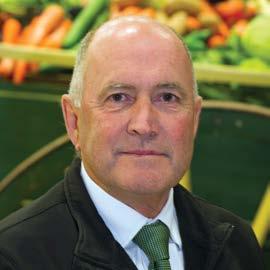
We just have too many moving policy proposals to be able to be specific with the policy outcome in our strategy, for example the Grocery Code of Conduct, or He Waka Eke Noa (HWEN), or Cyclone Gabrielle financial support, or Resource Management Act reforms, or Recognised Seasonal Employer scheme policy and so on. In the last financial year, we submitted on over 60 new policy proposals.
Some of the policy areas involved are really difficult and require huge amounts of work and leadership. Carbon neutral policy and HWEN for instance – government has a law requiring pricing for emissions to begin in 2025. HWEN is all about working collectively within the food and fibre sectors, with Māori, and government, to find a better option than the Emissions Trading Scheme which is the backstop in the law. We are doing just that, progressing an option that is farm level – not a tax, agrees that methane is different than nitrous oxide, recognises on-
Sometimes growers and product groups ask me about how it is possible for Horticulture New Zealand to advocate for policy settings on a national basis, as they believe the policy outcomes for vegetable growers are different from those for fruit growers. Or that apple growers will need different national policy settings than cherries, or potatoes different than peas, etc.
farm sequestration, and provides for minimal pricing, with any revenue collected to be recycled back to the sector for research to help reduce emissions. We will continue to work to develop an approach that will be a better outcome than what the backstop would mean, which is a blunter tax-like mechanism affecting all the primary sector including growers.
Another difficult but related policy is freshwater and the objective for freshwater management Te Mana o te Wai. Climate change and freshwater policy are related as both policies aim to reduce emissions: one into the air; the other into our waterways.
The National Policy Statement for Freshwater Management 2020 is part of the Essential Freshwater package. It gives national direction, which regional councils must put into action through their regional policy statements and plans.
It requires every regional council to identify values for freshwater for their region and to set outcomes, including water quality concentrations, flows and water levels for rivers, and to develop interventions to achieve the outcomes, or to take harder steps if deterioration is detected.
With these two major policies, which are hugely significant for all of the food and fibre sector and Aotearoa New Zealand, our HortNZ team has worked incredibly hard, along with product groups and district associations, to achieve the best possible future settings for growing. And to align them with our existing GAP assurance programmes rather
than have government impose another certification/assurance scheme on us. At a regional level some policy such as freshwater will have specifics depending on the catchment and river systems involved, but we are still wanting to achieve as much national consistency as possible. We continue to advocate for national direction that recognises the importance of the supply of fruit and vegetables, and the regulatory settings that allow horticulture to prosper in every region.
Where it gets even harder is when a catchment has over-allocated its natural resources, so there isn’t any more water to allocate, or rivers are already too full of nitrogen and phosphorus. But even here we are still advocating for the future of growing within environmental limits, such as for water storage schemes to enable growing to continue and expand or acknowledgement of the importance of domestic food security – growing vegetables and fruit to ensure a resilient food supply.
National policy advocacy certainly comes with its challenges. We haven’t been able to achieve all we have sought, but we will always do everything we can to secure future policy settings where growing is both possible and profitable.
From where I sit as both a grower and as chair of HortNZ, we can be pleased with the ongoing efforts of our HortNZ team to get the best results for us, even in a challenging political environment.
Kia kahaEditor:
Andrew Bristol
Ph: 021 021 62 021
Email: andrew.bristol@hortnz.co.nz
Advertising Manager:
Debbie Pascoe
Ph: 027 485 8562
Email: debbie.pascoe@hortnz.co.nz
Design: Scenario Communications
Ph: 04 385 9766
Email: joy@scenario.co.nz
Subscriptions:
Email: info@hortnz.co.nz
NZGrower is produced by Horticulture New Zealand and is free for all levy payers. The magazine is also supported by: Vegetables New Zealand Inc, Process Vegetables NZ, TomatoesNZ, Potatoes New Zealand Inc, Onions New Zealand Inc.
The individual comments and views in this magazine do not necessarily represent the view of Horticulture New Zealand.
ISSN: 2230-2700 (Print)
ISSN: 2744-5712 (Online)
This publication uses vegetable based inks and environmentally responsible paper produced from Forest Stewardship Council® (FSC®) certified, Mixed Source pulp from Responsible Sources.
Paper produced using Elemental Chlorine Free (ECF) and manufactured under the strict ISO14001 Environmental Management System.
The wrapper we use is 100% recyclable, it is LDPE 4 (Low Density Polyethylene) Soft Plastic and meets the required standards. For further information refer to: https://www.recycling.kiwi. nz/our-story
COUNTRY AT A CROSSROADS
New Zealanders by and large support our country’s horticulture industry, but this country is under pressure. While Horticulture New Zealand tells taxpayers about our passion for growing and shows them the strain growers are under, we must also understand the context of a country struggling to make ends meet. Without the support of the country, growing will only become harder.
We held the inaugural Horticulture Conference Week earlier this month. I would like to thank all the sponsors and product groups that worked with us to ensure the week was a success. Throughout the colder months, the six regional finals of the Young Grower of the Year also take place, with the national final taking place this year in Pukekohe on 4-5 October. Thank you to the regional organising teams as well as the sponsors for coming together to ensure these events are a success and highlight all the good things about the horticulture industry to a wider audience.
Considerable investment is made across our industry in events and meetings that bring growers together. Sometimes these events serve a particular purpose – for example, finding out more about proposals and gathering feedback on these proposals; or finding out more about decisions and how they affect growers. Other events are a chance for growers to reflect, offering them the opportunity to come together for a good yarn, while celebrating the success of our industry.
Growers grow because they are passionate about what they grow. Even though times are tough for many growers, the passion comes through in conversation at events. Indeed, there’s a strong drive to get back out there and grow – particularly if the sun is shining!
The strength of this passion cannot be underestimated but also, it cannot be taken advantage of. Organisations such as HortNZ try and reflect growers’ passion in their advocacy while maintaining dialogue with groups who have not experienced the passion, let alone understand where it comes from.
Sometimes the passion is overwhelming. This puts HortNZ in a difficult position. Our objective is to achieve as much as we can for growers in environments where many different things are taken into consideration. Call this the art of politics with a small ‘p’, even though it involves interaction with Politics with a big ‘P’. New Zealand is under a lot of pressure at the moment. The entire country has post-Covid inflation to contend with and a succession of adverse weather events and generally poor growing conditions are putting additional strain on growers.
There’s a strong drive to get back out there and grow
We need to focus on our industry’s goals within the context of the future of New Zealand. We rely on society’s support to grow. The term we give this is ‘social licence’. Yes, we could take a more militant approach, but HortNZ doesn’t believe that is in the best interests of the whole industry, because that could bring into question our social licence.

New Zealanders by and large are very supportive of our country’s horticulture industry. Indeed, they are proud, particularly when they see our produce on shelves overseas. Our industry has so many things going for it, now and in the future, particularly in terms of adaption to climate change and increasing New Zealand’s production of low carbon food.
We are at a crossroads. The government – and taxpayers –are offering support to adverse weather affected growers, because they do see the value of our industry and the healthy food that we produce.
However, the country doesn’t have infinite resources. Every day there are news reports of a deepening deficit for the country, with many other sectors and industries also calling out for government support. This is why we always need to be mindful of our social licence.
Platinum Sponsor

Silver sponsors

Bronze Sponsors
For 2024 sponsorship opportunities, please contact HortNZ Event Manager Kerrin Burns kerrin.burns@hortnz.co.nz






RSE Session sponsor










YOUR LEVY AT WORK

STRENGTHENING NEW ZEALAND’S ORGANIC BRAND
Emily
Organic horticulture is on the rise in New Zealand, due to increased consumer desire for spray-free food produced with environmental wellbeing in mind. From 2020-21, New Zealand organic fruits and vegetables produced $143 million of value, up 6 percent from 2017. Organics make up about 2.45 percent of horticulture by land area. Horticulture New Zealand represents levypaying organic growers alongside conventional growers in our policy and extension work.

After this year’s passage of the Organic Products and Production Act 2023, HortNZ is upping our efforts to engage with our organic growers. In June, we submitted on the Draft National Organic Standard, which will provide a unified list of rules holding all New Zealand organic producers to the same certification requirements. This will strengthen the New Zealand organic brand and give consumers confidence, at home and abroad, in our products’ environmental credentials.
To develop our submission, we reached out to organic growers and sector leaders at Organics Aotearoa New Zealand and BioGro and participated in sector forums attended by various organic advocacy groups. Our submission argued that the first draft of the Standard should align more closely with existing Standards to ease the transition for growers. We also called for the Standard to cover imported organic products as well as those produced here. We further asked that the Standard ensure that its rules for contamination testing and compost reflect the reality of an interconnected world that can never have guarantees of zero contamination. What is most important is that organic growers follow an agreedupon practice to minimise pollutants. Our submission was supported by New Zealand Kiwifruit Growers Incorporated, Strawberry Growers NZ, and Tomatoes NZ. HortNZ then submitted on the second draft of the Standard, calling for alignment of the organic principles with the internationally respected IFOAM principles of health, ecology, fairness, and care.
In early July, the HortNZ Environmental Policy Team hosted a policy catch-up with organic growers to inform them of our work in biosecurity, resource management and organic rules and to hear more about what their sector needs to succeed. The conversation yielded new connections and affirmed that there is potential knowledge-sharing to be had between conventional and organic growers given our industry’s shared commitment to environmental best practice. Moving forward, we hope to host quarterly catchups with the organic horticulture sector to ensure their priorities are included in our policy arguments.
Statistics sourced from Organics Aotearoa New Zealand (OANZ). Time for Action: 2020/21 New Zealand Organic Sector Market Report.
Organic growers who would like to participate can email emily.levenson@hortnz.co.nz.
HORTNZ WELCOMES NEW DIRECTORS
Growers have supported the appointment of three very capable and experienced directors on the Horticulture New Zealand Board – two new faces and one familiar. The focus on industry good body governance has never been higher as the horticulture sector grapples with one challenge after another.
Doug Brown and Alistair Petrie join the Horticulture New Zealand Board this month following the HortNZ Annual General Meeting held during the inaugural Horticulture Conference Week. The new appointments follow the departure of directors Kate Trufitt and Tony Howey. Director Hugh Ritchie was reappointed for a new term.
“It’s great to have Al and Doug joining the board, bringing new skills and experience,” says HortNZ president Barry O’Neil. “Both Al and Doug have extensive experience in horticulture and are also very capable and experienced governors. We look forward to their contributions, and I thank our grower members for supporting both.”
Doug has been active in agri-business leadership for more than 35 years. Together with his brothers, Doug runs a mixed dairy and kiwifruit operation – a herd of 3000, and a kiwifruit production footprint in excess of 100 hectares across Te Puke, Ōpōtiki and Gisborne, including a joint venture with local Māori in Te Kaha. Doug was previously chair of New Zealand Kiwifruit Growers Incorporated.
“Growers across the horticulture industry have faced significant challenges in recent times,” Doug says. “The role of HortNZ has never been more critical in continuing to advocate for grower interests, while building a sustainable environment for the industry to operate in and thrive.”
Alistair held senior positions in the Turners & Growers group of companies and Freshmax, before embarking on a governance and advisory career. His other directorships include Turners Automotive Group, Darling Group Holdings and Bartel Holdings, while he is currently playing advisory roles for Pāmu and Foodchain. He was responsible for setting up the Fresh Produce Importers Association and was a director of United Fresh.
“I have a strong conviction that grower/industry bodies need to be relevant to their stakeholders and need to evolve ahead of the curve to ensure they add value,” says Alistair. “The rapid consolidation, innovation and scale
of many growers means the focus of industry bodies is different to the structure of 20 years ago. I believe I can assist in this evolution.”
Hugh, an existing HortNZ Board director, retired from the board by rotation and offered himself for re-election for a new term. Hugh is the Managing Director of Drumpeel Farms, a family run farm in the Hawke’s Bay encompassing more than 2050ha of mixed cropping and livestock. More than 700ha is planted in crops including cereals, seed and process vegetables with the balance of the property being used for lamb and beef finishing.
“I am concerned that our ability to influence the significant policy reforms we are faced with is reducing,” Hugh says. “This is not due to effort or strength of argument but the changing way politics work.
The role of HortNZ has never been more critical in continuing to advocate for grower interests
“I think we need to look closely at how we work as an industry. We need to look at how we can engage with other industries – not just in the primary sector – to create a louder voice to effect change and reduce duplication, ensuring levy funds are spent in the most cost-effective way.”
Tony Howey retired from the board having completed nine years and therefore was unable to re-stand under HortNZ rules. Kate Trufitt did not offer herself for re-election due to changes in employment. Look out for our interviews with Kate and Tony in NZGrower this month and in September as they discuss their experiences on the board and their outlook for horticulture.
“I would like to thank Kate and Tony for their contribution on the board,” Barry says. “Both have been tireless in their advocacy for growers, particularly during the challenging last years as the industry grappled with Covid-19 and severe weather events.”
HortNZ advocates for and represents the interests of New Zealand’s 4200+ commercial fruit and vegetable growers. The HortNZ constitution provides for a term of three years for elected directors with one third of directors retiring by rotation each year.








 Murray Denyer Director
Doug Brown Director
Alistair Petrie Director
Brydon Nisbet Director
Hugh Ritchie Director
Kathryn de Bruin Director
Barry O’Neil President and Chairman of Directors
Bernadine Guilleux Vice-President and Director
Dr Bruce Campbell Director
Murray Denyer Director
Doug Brown Director
Alistair Petrie Director
Brydon Nisbet Director
Hugh Ritchie Director
Kathryn de Bruin Director
Barry O’Neil President and Chairman of Directors
Bernadine Guilleux Vice-President and Director
Dr Bruce Campbell Director
REGIONAL COMPETITIONS HEAT UP FOR YOUNG GROWER TITLE
Young growers competing for a place in the national Young Grower of the Year have impressed in this year’s Nelson, Bay of Plenty, Central Otago and Gisborne regional events. Fruit growers topped the regional competitions but vegetable growers were well represented at the Pukekohe contest. ANDREW BRISTOL reports.
The Young Grower of the Year is an annual competition run by Horticulture New Zealand to select the finest young grower in the country. Fruit and vegetable growers compete in regional competitions, with the winner from each of the six regions going on to compete for the grand title at the National Young Grower of the Year final. The competition is made possible thanks to the support of platinum sponsor the Horticentre Charitable Trust, prize money sponsor Countdown, gold sponsors Balance, FMG, Fruitfed Supplies, T&G Global, BASF and bronze sponsors South Pacific Seeds, New Zealand Frost Fans, Meridian and WorkSafe.
The winner of the National Young Grower of the Year has the opportunity to compete at the Young Horticulturist of the Year, run by the Royal New Zealand Institute of Horticulture Education Trust.

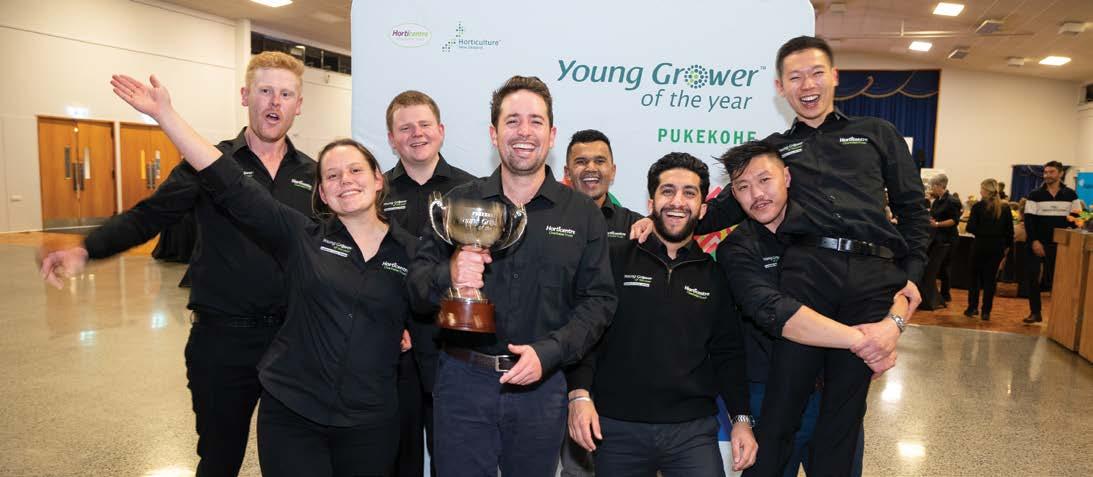
Contestants can use these networks for support and to run ideas by
This year’s Young Grower of the Year competitions kicked off in May with the Pukekohe regionals dominated by young vegetable growers. The competition tested the vegetable and fruit-growing knowledge of eight contestants along with the skills needed to be successful growers. Competitors completed modules in marketing, compliance, pest and disease identification, safe tractor driving, finance, soil and fertilisers, irrigation and quality control.
Taylor Leabourn, an
agronomist at LeaderBrand, took home the 2023 Pukekohe Young Grower of the Year trophy. Taylor says he came into the competition wantingto learn more and enjoy the day while seeing where his skill set was.

“It came as quite a nice surprise. We had a really good number of contestants this year, and a really diverse group with a mixture of outdoor vegetables, glasshouse, and fruit experience — a really good group of people. We had a lot of fun.”
However, at the remaining regional competitions in June and July, the contestants were all fruit growers. Although taking place in regions dominated by fruit growing, vegetable growers are welcome and encouraged to participate.
Kate Trufitt, retiring HortNZ Board member and incoming Potatoes NZ chief executive, says the Young Grower provides regional finalists with the opportunity to benchmark with their peers from across the country.

“Different regions grow different crops, so finalists get the opportunity to learn from each other. The competition also builds relationships and skills – skills for day jobs as well as leadership skills for future roles in the industry.”
Jess Cranswick, New Zealand Apples and Pears acting chief executive, says events like the Young Grower of the Year create alliances that can last a career.
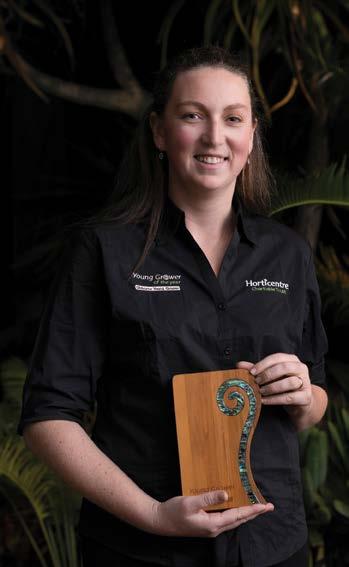
“These events create opportunities for young people to get together and develop networks. This is important when most growing operations are small, which can lead to feeling isolated.
“Contestants can use these networks for support and to run ideas by – ideas they might not feel comfortable testing with older people.”
This sentiment was shared by one of the event sponsors, BASF.
“We like to support events that encourage young people to come through the industry. We need to develop the next generation, as we need them to take over from us,” says BASF senior technical services specialist, Tim Herman.
“Ours is an exciting industry to be in, despite the ups and downs. It’s always changing and that creates opportunities for all sorts of different young people.”
Gregoire (Greg) Durand of Cherri Global in Clyde won the 2023 Central Otago Young Grower of the Year, Ōpōtiki orchard manager Sydney Hines won the Bay of Plenty Young Grower, orchard hand Dillon Peterson is the Nelson Young Grower of the Year and Emily Samuel, an apple and kiwifruit manager for Thompson’s Horticulture, took home the Gisborne Young Grower of the Year award.
The five winners will join the winner of the Hawke’s Bay Young Fruitgrower of the Year competition held in August at the Young Grower of the Year finals in October.
If you are a young vegetable grower or have feedback to help increase vegetable grower participation, please contact Kerrin Burns, events manager at HortNZ at: kerrin.burns@hortnz.co.nz
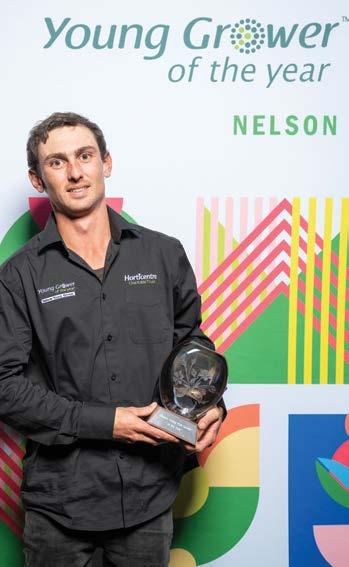 Dillon Peterson is the 2023 Nelson Young Grower of the Year
Ōpōtiki orchard manager Sydney Hines has won the Bay of Plenty Young Grower for 2023
Emily Samuel is the 2023 Gisborne Young Grower of the Year
Dillon Peterson is the 2023 Nelson Young Grower of the Year
Ōpōtiki orchard manager Sydney Hines has won the Bay of Plenty Young Grower for 2023
Emily Samuel is the 2023 Gisborne Young Grower of the Year
COLLABORATION, LISTENING, INNOVATION PART OF NEW LEADERSHIP
This month Kate Trufitt finished her term as director on the Horticulture New Zealand Board. She spoke with ELAINE FISHER about her experience on the board, her career in horticulture and her leadership vision.
Kate Trufitt’s roles within the horticultural industry have been many and diverse, each adding to her professional and personal growth, but it was being offered an associate directorship with the Horticulture New Zealand Board which cemented her interest in governance.
In 2018, Kate was the inaugural associate director for the board, and thanks to the experience gained from that role, she was successful in her bid to become an elected member of the board in 2020.
“I am glad I put myself forward for the associate position as I was not sure about governance at that time. It was a really good opportunity to learn how the board worked and the responsibilities involved. I’d recommend anyone offered the opportunity, to take up an associate role on a board.”
Associate membership is about succession planning and is a development opportunity for a future leader to join horticulture boards and gain experience in governance, leadership and strategy, says Kate.
Kate, who was elected as a grower representative on the board, has recently resigned from her role as group safety, compliance and sustainability manager with Apata Group in the Bay of Plenty, so did not put herself forward for re-election to the HortNZ Board.

“I had been with Apata for eight years, which included risk management during Covid-19. It had taken its toll and I decided I needed a change, so I’m taking some time to decide where to next,” says Kate, who is also a member of Women in Horticulture.
“I am really interested in leadership. It’s a concept which I think is changing because the way people want to be managed is changing. Today’s young people want to be treated differently than the Baby Boomers.
“Leadership needs to acknowledge that people want a safe place to work where they are appreciated and supported. Collaboration, listening and innovation are important. I’m interested in seeing how new leadership
develops and looking for a role in which I can explore those opportunities to add value and do something a bit different, and which resonates with me.”
Kate’s school years were spent in Whakatāne where her parents, who were keen gardeners, developed a herb business, growing 100 varieties of herbs and teaching others how to use them for culinary and medicinal purposes.
“My aunt and uncle had a boysenberry orchard at Te Puke where we used to help pick fruit when I was young.”
Those experiences were Kate’s first introduction to the horticulture industry, but it wasn’t where she began her working life. Kate found university wasn’t for her and found full-time employment in the interior design industry, starting with an Auckland company then taking her OE and returning to New Zealand to work for the same manager.
Kate’s career in horticulture began when she joined Cedenco in Gisborne in a marketing role, subsequently moving into logistics management.
“In 2005 I joined Riversun Nursery in a client services manager role responsible for all ‘business as usual’ aspects of the nursery from sales to production and logistics.”
Kate’s next move was to Kaiaponi Farms as market manager in 2008. “Here I developed industry market relationships and started on my journey of compliance
and health and safety. Leaving Gisborne in 2011, I joined Fresh Direct in Auckland in a human resources, and health and safety compliance management role.”
In 2015 Kate moved to Tauranga and joined Apata Group where her role grew to include the fields of health and safety, compliance and sustainability.
“I have been lucky with opportunities people have given me in the horticulture industry, and my growth has been organic rather than targeted and mapped.
“I do have a knack for spinning quite a few plates at the same time, and I have had good teams around me. I learnt early on that your team is really important, and inclusive management and regular communications are at the forefront of managing people and for getting the best from your team.”
Kate’s career pathway illustrates some of the diverse roles the horticulture industry offers, and she encourages young men and women to consider it as a career option.
To keep up-to-date with Women in Horticulture, its news and activities, and join the membership



KATE TRUFITT CONFIRMED AS NEW POTATOES NZ CHIEF EXECUTIVE
Just before NZGrower went to print, Kate accepted a new role as chief executive of Potatoes NZ, the industry association representing the interests of the New Zealand potato industry. Acting chief executive Jon Davison says that, following a rigorous process among a high quality pool of candidates, Kate was confirmed as the successful candidate to be Potatoes NZ’s new CEO with her proven experience in the horticulture sector providing a distinctive advantage. “Kate has demonstrated success with grower engagement that aligns strongly with the Potatoes NZ’s Board expectations for ongoing interaction with all our stakeholders. We
Communication with onsite contractors made easy
Zero Harm is simplifying health and safety onsite
NEW ZEALAND EXPANDS ITS TOOLBOX TO QUICKLY ERADICATE A STINK BUG INCURSION
Horticulture New Zealand supports the Environmental Protection Authority’s decision to change the rules around how the insecticide Actara® can be used if the brown marmorated stink bug (BMSB) invades New Zealand. Despite the known risk to bees and other pollinators, Actara is currently an important tool in trying to prevent a much greater catastrophe.
Ministry for Primary Industries (MPI) sought approval for the targeted spot spraying by MPI-approved biosecurity chemical operators in the immediate aftermath of a post-border incursion. Otherwise, New Zealand would be faced with few effective tools available for immediate deployment in the event of a BMSB incursion. Approval was granted by the EPA, subject to a number of controls. To further reduce the potential impact on bees, all beehives must be moved from the area for at least three weeks after spraying.
Horticulture New Zealand submitted in support of the application, supported by New Zealand Apples & Pears Incorporated, Summerfruit NZ and Tomatoes NZ.
Kiwifruit Vine Health and New Zealand Winegrowers also submitted in support of the application. HortNZ also presented at the hearing.
“Nobody wants to increase insecticide use,” says HortNZ’s Anna Rathé, who spoke at the hearing. “Part of producing a quality product is fruit that looks and tastes excellent and also has a low residue profile. The sector has been working hard to have low inputs of chemicals. So the ideal outcome would be BMSB not arriving at all. But we have to consider the possibility of it arriving. It’s one of our top threats – in the same category as exotic fruit flies. Considering the impacts of long-term management that other countries are facing, that’s a situation that we’re very keen to avoid.”
Actara is currently used to control insect pests on kiwifruit, pipfruit, and potatoes. MPI applied to increase its use from four applications per year up to a maximum of eight in a treatment location – only in response to a serious BMSB incursion – most likely in a localised or urban setting.
BMSB is one of the most serious biosecurity threats to New Zealand. They can cause crop losses in a wide range of crops, including fruit trees, kiwifruit, corn and other vegetables. Overseas crop losses of 90 percent have been reported. A New Zealand Institute of Economic Research (NZIER) report produced in 2017 estimated that if BMSB
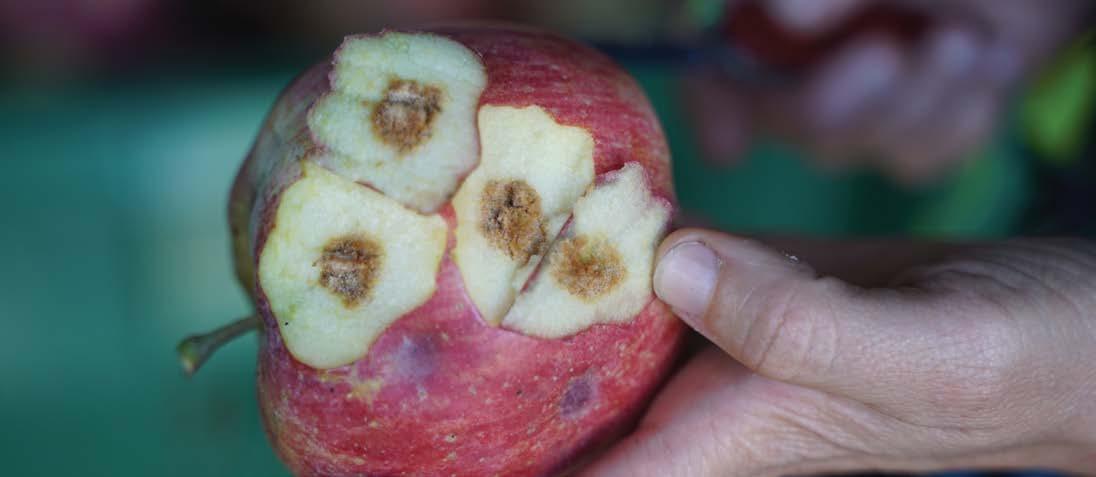
result in a $3.6 billion drop in GDP by 2038 were to become established in New Zealand it could result in a $3.6 billion drop in GDP by 2038. It predicted horticulture export values could fall by up to $4.2 billion over this period.
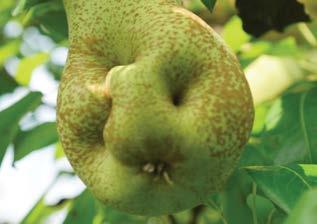

The stink bugs are in more than 30 countries and have caused billions of dollars in economic losses to global agriculture. While New Zealand has never had an established population of BMSBs, MPI has frequently intercepted the pest at the border.

As part of the government and industry partnership in the Brown Marmorated Stink Bug Council, HortNZ has put a lot of time, energy and resource into getting prepared
for this pest. Initiatives include a world-first pre-emptive biocontrol approval of samurai wasp Trissolcus japonicus, development of a comprehensive biosecurity response plan, a national surveillance programme and public awareness campaigns.
Fit for the future – proactively influencing policy

HortNZ submitted on:
• Proposed reassessment of Actara® for use in a BMSB incursion


The planet’s favourite slug bait
The brown marmorated stink bug is one of our top border incursion threats – in the same category as exotic fruit flies – and couldYOUR INDUSTRY

THE STATE OF CALIFORNIA TECH

Better biology: better crops.







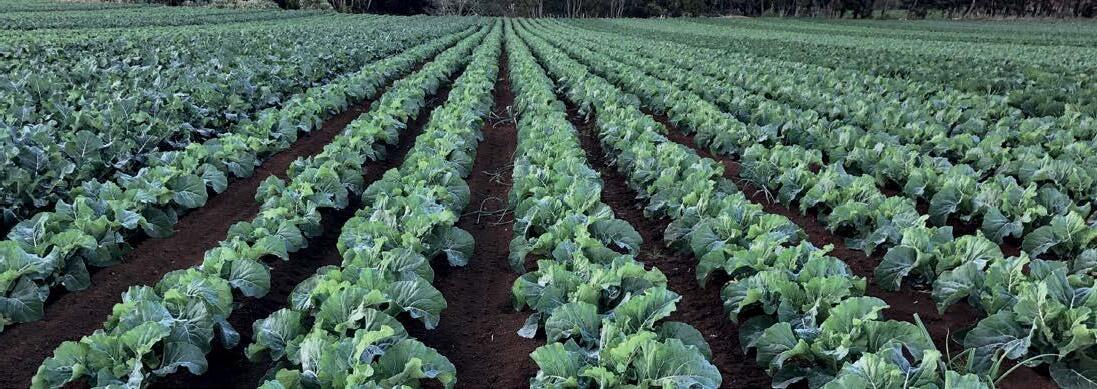
WHAT WE CAN LEARN FROM CALIFORNIA
Callaghan Innovation Californian Market Immersion Tour
Callaghan Innovation is a government entity similar to New Zealand Trade and Enterprise with the purpose of delivering the Agritech Industry Transformation Plan (ITP) to wider markets. Immersion tours are designed to immerse budding New Zealand tech companies to potential export opportunities in selected markets suitable for their technologies.

Innovation discovery is not a journey you travel alone

New Zealand, an agriculture focused economy, is unique in its ability to pump out agriculture innovation. As I have found out while participating in an immersion tour, New Zealand has much to offer our cousins in Australia, the Americas and Europe. Not only is our tech at a leading edge, so is our position on the climate scale. All regulators seem to be fixated on nitrogen, water and climate (CO2). They are global problems that will need global answers. It stands to reason when you think of climate and New Zealand’s impact on CO2 (1 percent). Whatever New Zealand growers
do in climate change is not going to change the dial. But if California decides to change practices in CO2 mitigation, being the fourth largest economy in the world, this will impact CO2 mitigations.
Some of the work we are undertaking in A Lighter Touch, the Sustainable Vegetable Systems project, regenerative farming, renewable energy, NZGAP – EMS module are all being undertaken to some degree in California. There regulators are tackling the issues slightly differently due to the nuances of the environment, legal and cultural perspectives. The outcomes are similar in that they are trying to sustain economic outcomes, while preserving the soil health and wider natural environment and community. Resources are becoming scarce so how do land holders preserve or enhance the natural value of the land for future generations to come?
The tour makeup was a quadruple helix of resource extension. It involved government (Callaghan Innovation), research (Plant & Food Research, A Lighter Touch, Lincoln Agriscience), industry (Vegetables New Zealand), growers and innovators. Evidence suggests that if the tour participants are from all parts of the supply chain, the knowledge exchange will be more rounded and solutions are likely to be integrated with a high chance of success.
Innovation discovery is not a journey you travel alone. The great minds of California and around the world understand that to turn the dial on horticulture sustainability will take all parties in the supply chain. A rising tide lifts all boats. The first step is to get involved –go to an international conference and listen, discuss, and learn. The next step is to get involved in some technology that will deliver a bottom line to your business. It is better to share the risk, so partner with an agency that can deliver scale thereby lowering the ROI metrics. In the USA newer technology like AI weeding is undertaken as a service model where growers hire the service for a period of time. Usually at a rate that is slightly less than a manual weeding operation equivalent.
2023 Salinas Biological Summit
Western Growers Association and the state of California gave the 2023 Salinas Biological Summit real impact. So too did the growth of the industry with plenary speaker Pam Morrone stating that “biologicals could equal chemicals in 20 years – the market size is $110 billion.”

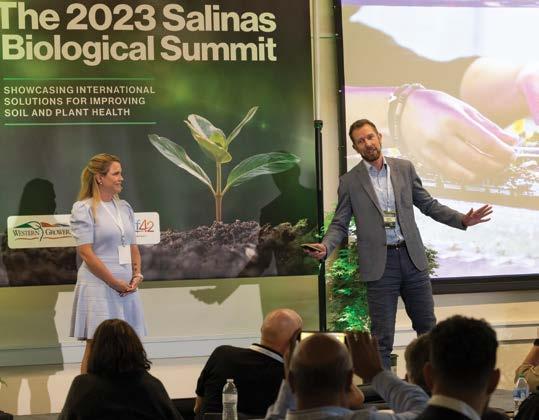

The summit was a first for California with over 50 local and international speakers. The US has been developing biologicals for over 30 years. The US Environmental Protection Agency / US Department of Agriculture have a special authority to manage the registration process. What made this different is that California has just passed regulations for a Sustainable Pest Management Roadmap – a holistic integrated approach to pest management that connects ecosystem health with community wellbeing for the control of pests. Biologicals sit at the heart of this system. More about the summit in a later article. Teaser: biostimulants are available in New Zealand, RNAi technologies are not.
Share your thoughts with Antony: antony.heywood@freshvegetables.co.nz
Better biology: better crops.
Mycorrcin - activates the soil microbes that enhance root growth & nutrient uptake. Foliacin - activates foliar biology for foliar health and lifts photosynthesis. Digester - activates decomposition microbes to break down old crops & recycle nutrients faster. Biostart N - nitrogen fixing bacteria that provides nitrogen to your plants without excess runoff. Terracin - rebalances soil biology Triplex - controls botrytis.







 John Murphy, Chair of VNZI, centre, joined an international panel discussion on implementation of biologicals into current systems
Simon Yarrow, Agritech ITP lead at Callaghan Innovation, shared New Zealand’s current horticultural landscape with delegates at the 2023 Salinas Biological Summit
John Murphy, Chair of VNZI, centre, joined an international panel discussion on implementation of biologicals into current systems
Simon Yarrow, Agritech ITP lead at Callaghan Innovation, shared New Zealand’s current horticultural landscape with delegates at the 2023 Salinas Biological Summit
“MANDATES ARE THE BEST WAY TO FAIL”
Stuart Davis : LeaderBrand sustainability manager
Stuart Davis from LeaderBrand Produce was one of several growers who took part in the Callaghan Innovation/Vegetables NZ California Market Immersion tour in June.
California has long been regarded as a bellwether for the global produce industry. Its massive scale is reason enough: at over US$51 billion in farm-gate value across over 400 commodities, it represents over 10 percent of US agricultural output including more than a third of the nation’s vegetables and three-quarters of its fruit and nuts. California is also the most urbanised and densely populated state and one of the most politically liberal. Combine all that with the high climate change risk factors of a Mediterranean climate and a long coastline and you have a place to watch when it comes to climate change adaptation by a horticultural industry.
The key drivers for change are the same as other places and include regulatory pressure. The first pain point is water. The state’s Sustainable Groundwater Management Act will require the retirement from farming of 300-400,000 hectares in the Central Valley by 2040 to provide for groundwater recharge [see photo opposite]. This involves a massive planning effort to determine alternative land uses, compensation packages and redevelopment of affected rural communities.
The Golden State has some ambitious goals when it comes to climate change mitigation. These include: reducing greenhouse gas emissions 48 percent below 1990 levels by 2030 and carbon neutrality by 2045, a 94 percent reduction in petroleum use between 2022 and 2045, and an 86 percent reduction in total fossil fuel use. Agriculture represents only 10 percent of the state’s greenhouse gas emissions but is highly visible and expected to play its part in reductions.
A wise farmer, renowned for having an aphorism for every occasion, once said to me “People are like cattle. If you want them to move, you have to give them somewhere to go.” Since 2014, the state of California has invested more than US$800 million in a suite of Climate Smart Agriculture programmes which provide technical and financial assistance to farmers to adopt practices that reduce greenhouse gas emissions, increase carbon sequestration, increase water efficiency, conserve farmland and wildlife habitat and limit urban sprawl.
A similar approach is seen in the Sustainable Pest Management Roadmap released in January after nearly two years of development by a stakeholder group that included farmers, urban communities, environmental groups, tribes, researchers and government agencies. This sets some goals for the elimination by 2050 of the use of ‘Priority Pesticides’ by transitioning to sustainable pest management practices (in both agricultural and urban environments). As you might expect, the criteria for classifying ‘Priority Pesticides’ include their hazard and risk classifications. However, they also take into consideration other factors such as the availability of effective alternative products or practices, and the risk of resistance development.
Echoing my wise farmer friend, former local politician Leon Panetta (wise enough to be Chief of Staff for one US President and Secretary of Defense for another) told the Salinas Biological Summit that “Mandates are the best way to fail”. His recipe for success included collaboration, cooperation and research between growers, innovators and government agencies and an equitable transition period. Paraphrasing his comments about the educating the urban population about the importance of food security: “You don’t get to dispense with farmers just because you have a Pak’n’Save.”
Ahead of regulation, growers are already moving rapidly to more sustainable pest management. In her overview of the global market to the Salinas Biological Summit, biologicals pioneer Dr Pam Marrone estimated that 70 percent of biological products are sold to conventional (rather than

organic) growers. She presented projections of compound growth rates for biocontrol, biostimulant and biofertiliser segments of 12-14 percent for the years 2018-30 and predicted that the value of biologicals would equal that for synthetic products as soon as 2043. A key theme repeated through the summit was that most often biological solutions need to be evaluated as part of an integrated preventative programme rather than as stand-alone curative silver bullet and this requires a change in approach from researchers and regulators.
Alongside regulatory change, consumer and demand chain interest in sustainable practices was a key driver for rapidly increasing regenerative and ‘organic’ farming practices witnessed amongst California growers. Perhaps more important for the long term was the determination amongst fourth and fifth generation growers to future-proof their family businesses for the generations to follow.
While the environmental issues in California might be the harbinger of problems to come for our sector, there is good reason to expect that some of the solutions will also come


Good old-fashioned agronomy: field margin floral resources in a regeneratively farmed broccoli field

from there. One big advantage that California has is the so-called ‘meeting of the valleys’: the nexus between Silicon Valley (artificial intelligence, computer vision, robotics, venture capital) and Salinas Valley (agricultural machinery and large-scale vegetable production). The rapid progress made there to get autonomous tractors [see photo opposite] and work platforms and the various forms of robotic weeder (spotspray, mechanical and laser) into commercial use are clear examples of how technology can play a part in solving operational and environmental problems.
Good old-fashioned agronomy will also hold some of the answers [see photo above]. The fastest way to speed that up is some counter-seasonal collaboration which can be expected following the connections made between the reciprocal visits between the two industries in New Zealand in October 2022 and California in June.
Share your thoughts with Stuart: stuart.davis@Leaderbrand.co.nz
Better biology: better crops.
Mycorrcin - activates the soil microbes that enhance root growth & nutrient uptake. Foliacin - activates foliar biology for foliar health and lifts photosynthesis.




Digester - activates decomposition microbes to break down old crops & recycle nutrients faster. Biostart N - nitrogen fixing bacteria that provides nitrogen to your plants without excess runoff. Terracin - rebalances soil biology Triplex - controls botrytis.



 Large areas of walnut and almond orchards have already been ‘fallowed’ as part of the reduction of farmed area in the Central Valley
Large areas of walnut and almond orchards have already been ‘fallowed’ as part of the reduction of farmed area in the Central Valley
INNOVATIVE TECHNOLOGY IS AN EYE-OPENING EXPERIENCE
Woodhaven Gardens’ head of agronomy Maria (Cote) Solovera was a member of the Callaghan Innovation Californian Market Immersion Tour 2023. This report presents a general overview of the innovative technologies employed by California farmers to maximise production efficiency and address labour challenges in the agricultural sector.
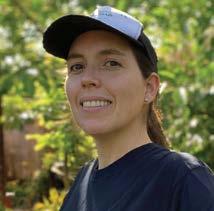
California’s privileged climate and ample arable land create ideal conditions for growing a wide variety of fruits and vegetables, allowing the state to feed a significant portion of the US population. However, the scale of intensive production and limited labour resources creates the necessity of developing new and efficient technologies to enhance productivity.
Visiting California farms provides an eye-opening experience, showcasing the challenges faced by farmers and the potential of agricultural technology. As a vegetable grower, I was particularly impressed by the technology advancements to reduce the amount of pesticide used while protecting the health of the soil.
There are different interesting weeding machines. The laser weeder by Carbon Robotics is a smart technology capable
of recognising and eliminating any type of weed without touching the crop. Additionally, it can be utilised for thinning crops by selecting the best plants based on crop spacing and even eliminating weaker plants when multiple plants are in proximity.
Another option is the mechanical weeder by Stout Agtech, which intelligently recognises the crop and avoids damaging it. With adjustable blade spacing and customisable configurations, this technology can adapt to different crops and planting configurations. Moreover, it can be used to assess crop health and population if necessary (this can be used in combination while doing the weeding or by itself if required).
Selected pesticide sprayers equipped with cameras have also gained popularity in California. Detecting and spraying only the crop significantly reduces agrochemical usage. When applied during the early stages of crop growth, it could save up to 80 percent of agrochemicals. This practice saves money on pesticides and protects the soil health, which is the most important factor for a sustainable future of agriculture.
Similarly, the weed spot sprayer utilises similar technology to detect weeds and precisely apply treatment. By using caprylic acid, it can effectively eliminate weeds within hours of application. This machine has the capacity to spray 1.5 acres per day, travelling at a speed of 1.2-1.5 miles per hour.

In addition to weeders and sprayers, smart moving robot platforms have proven to be valuable assets in agriculture. These platforms can perform tasks that are increasingly difficult to hire enough labour for by taking on responsibilities such as thinning, pruning, and harvesting in the field. Grading and sorting fruits in packing facilities also has included technology which makes the process quick and precise, with the use of rotating belts with cameras which are checking fruit defects, labelling, and grading them accordingly. All this technology enhances the quality of farm work and provides financial benefits for farm owners.


The use of technology has revolutionised the agricultural sector in California, helping farmers overcome labour


challenges and maximise production efficiency. The utilisation of weeding technologies, smart pesticide sprayers, and robot platforms has significantly transformed farming practices. Continued innovation and the adoption of advanced agricultural technologies are crucial for further optimising production outcomes and ensuring the sustainability of California’s agriculture industry. Even though the scale of production may differ significantly to New Zealand, we still face the common challenge of labour shortages and the need to maximise existing resources, to achieve a more efficient method of production.
Share your thoughts with Maria: maria@woodhavengardens.co.nz
The mechanical weeder by Stout Agtech intelligently recognises the crop, its blades opening and closing around the plants as it goes along the bed “Burro” is a smart robot platform designed to follow people and navigate autonomouslyMG CELEBRATES 100 YEARS OF GROWING TOGETHER
Market Gardeners Limited (MG) has deep roots in New Zealand, stretching back to 1923. It all began with a small group of resolute growers from Lower Hutt who felt that unfair practices from the auction merchants were impacting the value they received for their produce. In response, they embarked on an extraordinary endeavour –the formation of a grower-owned produce sales and marketing cooperative, which aimed to serve the hardworking men and women who dedicated themselves to producing fresh fruits and vegetables.
The MG story unfolded at a time that saw New Zealand grappling with the aftermath of the First World War which cast a dark shadow over the country and the Great Depression looming large on the horizon. Amidst this tumultuous backdrop, 81 original shareholders pressed forward, each committing a significant sum of between 10 and 50 pounds and on 21 September 1923, Market Gardeners Limited was officially registered.
It seems entirely appropriate that its first auction was held on Guy Fawkes Day (5 November) in 1923. On that morning, just before daylight, a long trail of trucks loaded with fresh produce and cars carrying the directors of the recently formed company was winding its way into Wellington. It was the culmination of relentless hard work from a group of determined growers who firmly believed in fairness.
One of the original founders was Lower Hutt grower Justin Pescini. The family business has become MG’s longest serving growers, over the years supplying everything from

Peter Hendry is chief executive of MG, which represents 400 shareholders and serves over 1000 customers


rhubarb to Italian tomatoes. Today the business is based near Levin, and specialises in potatoes and onions across 250 hectares, with a lot of their product still sold through MG markets in the lower North Island. The business is owned and managed by fourth generation growers, Chris, Andy and Brent Pescini.
Speaking about their history, Chris says they moved out to Levin following the second World War, after the land the family owned was acquired by the railways.
From a very modest start, MG is now proudly a leading, integrated Australasian produce business





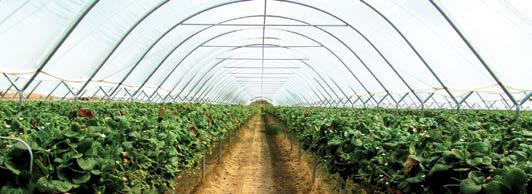



“My grandfather, Justin, was one of the early Italian market gardeners in the region, where his family had five acres on the site where the Knox church is today,” says Chris. “Because the railway was coming through part of their property, they looked further afield. First, they stopped near Tara Road, put a shovel in and it barely moved because of the stones so they carried on to settle near Queen Street East in Levin.”
Chris, Andy and Brent’s father, John Pescini, who has retired, is happy to share memories of MG and talk about his family’s involvement.
“Dad (Justin) had a reputation as someone who was hard but fair,” says John. “Setting up Market Gardeners was just about being fair – don’t be a burglar – treat everyone the same and don’t have favouritism.”

“I believe that around in Courtenay Place [in Wellington] was where these fellas, a lot of Italian and Chinese growers, would have their breakfast after being at the markets and talk to one another. This is where the idea of Market Gardeners got talked about and, well, they did something about it”. At the time, the actions of those early pioneers was described as revolutionary because it meant the end of an old established practice of only privately owned firms selling produce and the introduction of cooperative practices. The goal was to build a sound auction and marketing business, owned by growers, which would enable producers to reap just reward for their efforts. A century on, Market Gardeners Limited remains a cooperative company, owned by its members, most of which are current grower-suppliers.
“The theme for our centenary year is ‘growing together for 100 years’, which reflects the strong sense of togetherness of our cooperative and is a nod to the significant progress we’ve made alongside our growershareholders since MG first started operating 100 years ago,” says MG CEO, Peter Hendry.
MG OVER THE YEARS


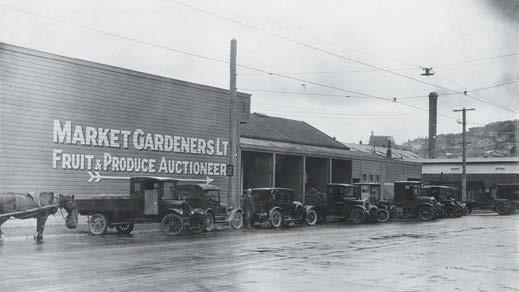
1950s: Levin growers J Pescini and Sons, one of the founding growers behind MG, and their Commer lorry

2023: Retired grower John Pescini and his son Chris, who together with brothers Andy and Brent runs the family business Pescini Bros Limited –MG’s longest serving growers

PLANT FOR SUCCESS
Sugarsweet
A black round watermelon with dark green stripes. Deep red flesh, good flavour and generally a high 13° Brix. 3.5-6kg. For 2nd early to late season harvest. Can be used under cloche. Holds and ships well.

Macxize
150-170gm deep round long shelf life tomato for loose pick or truss. High total yield, with good quality, well shaped fruit year round. Exceptional setting ability. Strong plant, easily balanced. Great disease package with intermediate resistance to powdery mildew.

Haupiri
Good vigour crisphead for late spring to early summer harvest. Excellent uniformity, neat frame and clean butt. Medium dark green colour. Flat round head of medium-large size. Consistent heart fill with good wrapper leaves. Resistance to Bl 1-36 and Nasonovia.
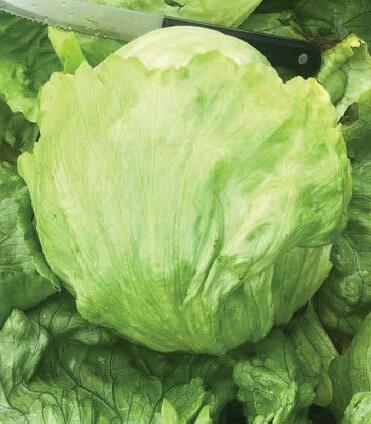
“Celebrating a century of trading is a remarkable feat for any business, but it holds particular significance for a cooperative involved in the sales and marketing of fresh produce.”

procurement, flower auction, IP and growing operations. MG is also New Zealand’s largest importer of fresh produce, which is linked to the partnerships they have formed with large international produce brands such as Dole and Sunkist.
“While the founders are central to the MG story, marking our 100 years is also about celebrating our current loyal growers and customers, our MG teams and the communities we live and work in,” says Hendry.
“There have been many tumultuous times, but the longevity and success of MG is largely down to the willingness for past directors and leaders to make bold decisions and evolve the company. From a very modest start, driven by a handful of passionate growers, MG is now proudly a leading, integrated Australasian produce business.”
Today, MG represents over 400 shareholders and serves over 1000 customers – providing everyday Kiwis with access to fresh, healthy produce.
“MG has always had a strong focus on being intergenerational, ensuring we’re not only serving and rewarding our current growers and shareholders, but also having a long-term view to ensure the benefits are enjoyed by others in the future – it’s a principle that underpins the cooperative model and aligns with values that MG was founded on 100 years ago.”
Over the years the cooperative has expanded on its core business of selling and marketing fresh produce on behalf of New Zealand growers, investing in complementary businesses including export, specialist
“We have a series of regional events planned throughout the country in November and will host a celebration dinner for all shareholders at Te Papa in Wellington.”
An MG 100-year website has been developed with historical content and information about how to find out about the celebration events. Through the website, growers, shareholders, customers and staff can share images or memories about MG.
Share your memories of MG at: mg100year.co.nz

The theme for our centenary year is ‘growing together for 100 years’1993: Produce trading on the market floor at MG 1975: Market Gardeners Limited Christchurch branch on Madras Street
TODAY, MG REPRESENTS OVER 400 SHAREHOLDERS AND SERVES OVER 1000 CUSTOMERS PROVIDING EVERYDAY KIWI’S WITH ACCESS TO FRESH, HEALTHY PRODUCE
CARBON POSITIVE – A SIX-YEAR TRIAL OF REGENERATIVE CROPPING
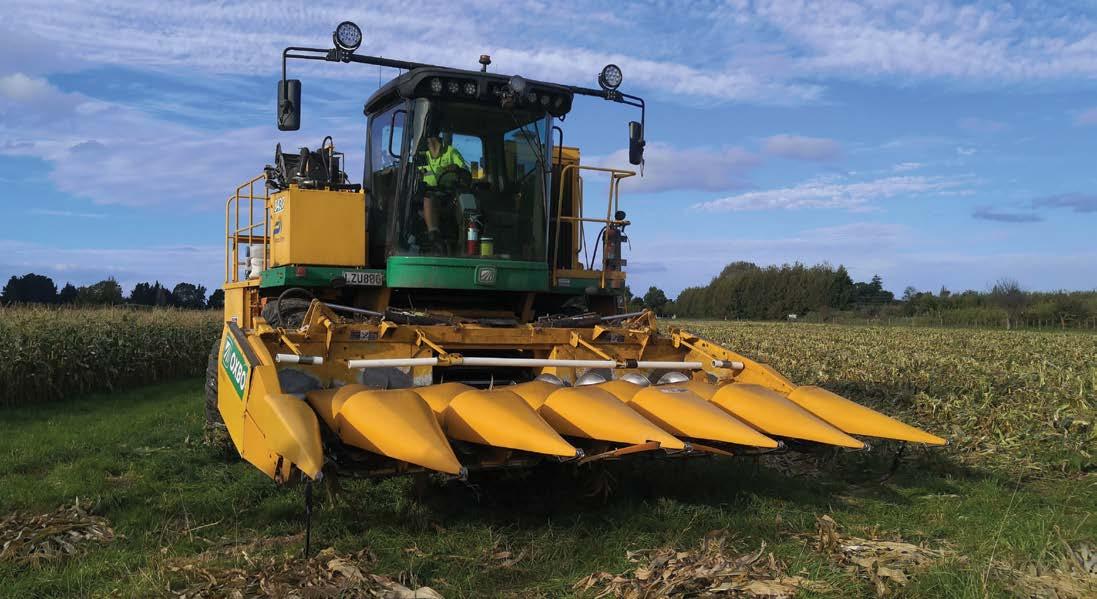
Interest in a six-year research programme into regenerative agriculture techniques is sure to increase as growers recover from Cyclone Gabrielle. In partnership with the Hawke’s Bay Future Farming Charitable Trust, LandWISE is running ‘Carbon Positive’, a trial looking at the economic and environmental effects of adopting these techniques in a process cropping system. It is particularly interested in comparing a regenerative production system with conventional systems, and the effects of each on longer-term cropping soils.
Alex Dickson from LandWISE says key questions include finding out if soil carbon levels, other soil health indicators and crop gross margins can be increased. “We are doing a huge amount of measuring of soil, crop and management variables, from soil carbon to 90 cm deep, plant germination rate and population, to the cost of
applying slug bait. We anticipate it will take the six years to let the systems fully establish and be able to confidently measure differences.”
We are doing a huge amount of measuring of soil, crop and management variables
To do the research, the LandWISE MicroFarm has been split into three different management systems, conventional versus regenerative, and a hybrid system that cherry-picks elements from the other systems. Four replicates of each are randomly allocated, and each plot is 12 metres wide and 90m long, so standard farm and contracting equipment can operate.
Dan Bloomer from LandWISE says they don’t want to be seen as white-lab-coat boffins being impractical.
“So the whole thing is set up to mimic what real farmers can do. We use the same machinery and contractors
Glenys Christianthat farmers use, and won’t do anything that couldn’t be realistically scaled up to 20 or 200-hectare paddocks. And then we use sound science practice to be sure data we gather is valid and can generate reliable information.”
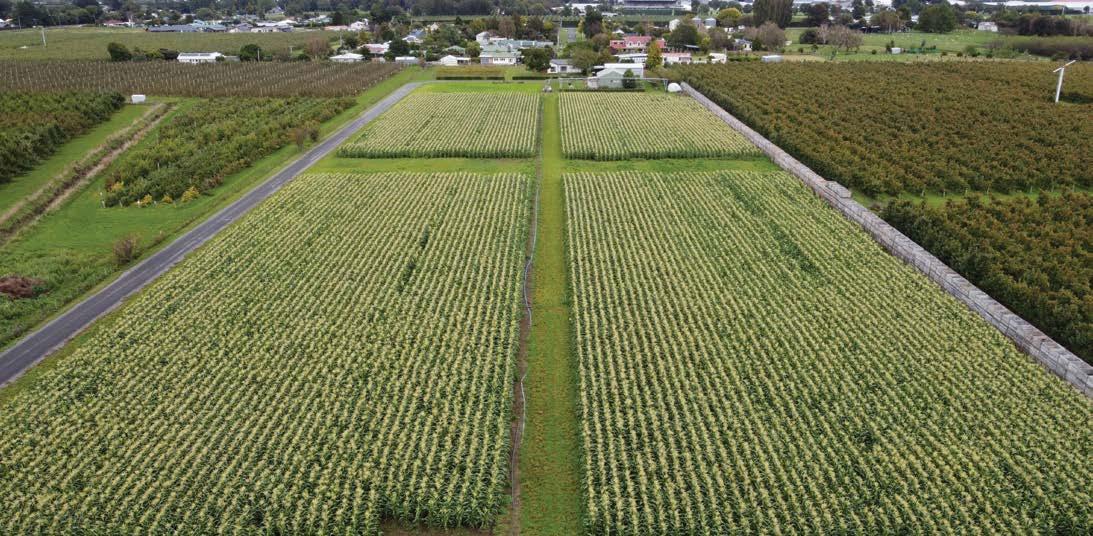
The conventional approach mirrors the system used by most farmers for the last few decades, using full cultivation, applying mineral fertiliser, and agrichemicals to control pests, weeds and diseases. Soil regenerative practices aim to minimise soil disturbance, keep it covered as much as possible, grow a diverse range of species, and keep living roots in the soil at all times. Global regenerative agriculture often talks about introducing grazing animals, the context being long-term mono-cropping of cereals or cotton for example. In Hawke’s Bay, winter lambs are a normal part of many farm systems.

The whole thing is set up to mimic what real farmers can do
“That one is still in discussion – our advisory groups see benefits in removing animals, avoiding the soil compaction they cause, and extending the cropping window.”
The regenerative system advisors suggest growing maximum biomass and feeding it to the “earthworms, microorganisms and others that live in the soil” might be a better option.
“It’s a six-year project, and I expect those questions will resolve themselves in time,” says Dan.
Both McCain Foods and Heinz-Wattie’s are involved in the research, alternating annually and growing crops as they
would normally. The year 2022–23 was a ‘McCain’ year and sweetcorn was first off the block. The crop was recently harvested and the MicroFarm has been sown in winter cover crops. The year 2023–24 is a ‘Wattie’s’ year, and the chosen crop is to be tomatoes.
The sweetcorn crop was sown late, didn’t have the usual amount of sunshine and was flooded for several days during the cyclone. But it fared better than many Hawke’s Bay crops. While results haven’t yet been analysed, Alex says it seems that the soil regenerative crop yield was slightly lower than the other two, and costs were higher.
COMPARING REGENERATIVE AND CONVENTIONAL SYSTEMS
SOIL HEALTH TO 90 CM DEEP
SOIL, CROP AND MANAGEMENT VARIABLES


PLANT GERMINATION RATE AND POPULATION
COSTS INCLUDING CONSUMABLES
“But it is the first crop, and we expect the management changes will take time to bed in. It will be interesting to compare a corn crop again in a few years’ time.”
Other process crops grown during the trial are anticipated to include beetroot, green beans and peas. Cover crops will include ryegrass and several single or multi-species cover crops such as oats, vetch and lupins.
Each system is actively managed with advice from farmers, contractors and industry providers. The Ministry for Primary Industries (MPI), Hawke’s Bay Regional Council, McCain Foods, Heinz-Wattie’s, BASF, Hawke’s Bay Vegetable Growers Association and Hill Laboratories are funding and supporting the research, along with support from the neighbouring marae.
Calibrating spreading equipment used in the Carbon Positive regenerative cropping trial at the LandWISE MicroFarmSUPPORT FOR THE NEW ZEALAND STRAWBERRY INDUSTRY TO TRANSITION INTO INTEGRATED PEST MANAGEMENT
On the back of a very successful three-year Sustainable Farming Fund (SFF) research project on ‘Future-proofing thrips management in strawberries’, scientists from Plant & Food Research (PFR) along with Strawberry Growers New Zealand (SGNZ) and Berryworld Ltd secured a further one year of funding for knowledgeexchange activities.
While the research undertaken in the initial SFF project provided new knowledge, outcomes and tools needed to guide the industry towards implementing integrated pest management (IPM), Covid-19 travel restrictions meant that the face-to-face and implementation support parts of the project to pass on new knowledge could not be conducted.
The industry’s reliance on non-selective insecticides is unsustainable in the long term. They now have new knowledge to assist them in building successful IPM programmes for their farms. However, implementing a new system requires support to ease the decision-making and for the growers to gain confidence.

To ensure this, the one-year extension of the original project was undertaken. The work in the extension focused exclusively on knowledge-exchange activities and implementation. This was driven by more hands-on and in-person activities to help growers and associate members transition to IPM.
In October 2022 several hands-on workshops were held across New Zealand for growers to gain in-depth knowledge and first-hand experience with the pest and beneficial insects in their crops. The growers became much better acquainted with the different insects by seeing them under a microscope, an essential skill to ensure that the monitoring done by the growers provides a solid foundation for any management actions. The workshops also allowed them to talk directly with the experts.
Overseas experience was included in the project via Paul Horne and Rebecca Addison from IPM Technologies Pty Ltd in Australia. Paul, an IPM specialist has, through a fellowship awarded by AGMARDT (The Agricultural & Marketing Research & Development Trust), been involved with the project from the start. He has been a great sounding board for the growers while sharing his expertise and experience in relation to the Australian strawberry growers switching from traditional pest management to IPM.
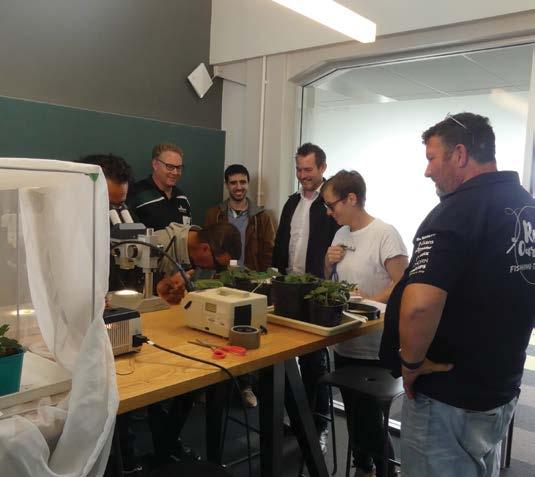
At the workshops, Paul took the growers step-by-step through how to build a tailor-made IPM programme for their own farms to facilitate pest management decision-making.
Following the workshops, two webinars were planned for April 2023. Growers were asked to vote on topics that they wanted to be covered at the webinars, and which would have additional resources developed.

One area identified was how to use and look after the beneficial insects released for management of pests, and a webinar was dedicated to this.
Beneficials are vital for successful IPM in any system



“Beneficials are vital for successful IPM in any system. Using biologicals in your crop creates new challenges –it’s a living system and you must be a caretaker to get the best out of them,” says Chris Thompson from Bioforce Ltd.
PFR scientists also presented on compatible behavioural control options such as pheromones, and introduced growers to online resources that will help them in deciding on compatible management tools.
Overseas experience and expertise in implementation governed the second webinar.
The aim was to highlight potential barriers and issues the growers could face during IPM implementation, and to give them more confidence in the IPM system and their decision making.
The project team developed a varied programme for the second webinar, including a European speaker, a trip for a New Zealand grower, and Paul Horne developing an IPM programme with a New Zealand grower.
As part of the programme, a New Zealand grower representative, Boman Zakeri, made a trip across the ditch to see first-hand how IPM was implemented at a large-scale commercial operation, and to talk with Australian growers about any barriers and challenges they initially encountered when transitioning to IPM. While the Australian growers’ transition was much more ‘forced’ owing to severe resistance issues to their chemical sprays, many similar concerns and questions related to the initial implementation of IPM will be the same for the New Zealand growers.
“Getting beneficials in early was a key lesson learnt from the Australian growers,” New Zealand grower Boman Zakeri shared with the wider audience in the webinar. Using a step-by-step process, Paul Horne helped Boman with the development of a custom-made IPM programme for his covered and open field crops.
In addition to the speakers attending the webinar, knowledge and experience were also shared via a pre-recorded presentation made especially for the webinar by Nina Jørgensen from Borregaard Bioplant ApS in Denmark. Nina is a specialist in the use of beneficial insects and assists Danish strawberry growers with their IPM programmes.
All the resources produced were shared with the growers via the SGNZ website, to ensure the information remains available for future use and to help the growers transition to IPM with more confidence.
TRACTORS FROM THE ARCHIVES
This month we’ve been diving into our magazine archives at the Horticulture New Zealand office. The NZGrower magazine has been published for growers since 1945… that’s more than 800 issues telling the horticulture story for New Zealand’s vegetable
and berry growers. What we especially love in our old issues are the shots of vintage machinery. What is your favourite vintage machinery? Share your photos and stories for the next issue of NZGrower. Email the editor@hortnz.co.nz.
Kubotas in the eighties
Norwood has been celebrating its 75th anniversary this year with a range of photos from their past. These ones were taken in the 1980s – the decade they secured the Kubota franchise. Kubota used New Zealand as a testing ground in the eighties. The conditions here helped them to build their tractors tough and develop their reputation for performance and reliability.



Do you recognise this tractor?


This image popped up in our image storage, but we can’t place which issue of NZGrower it was used in or the location of the photograph. If you recognise the machinery or where it is operating, get in touch!
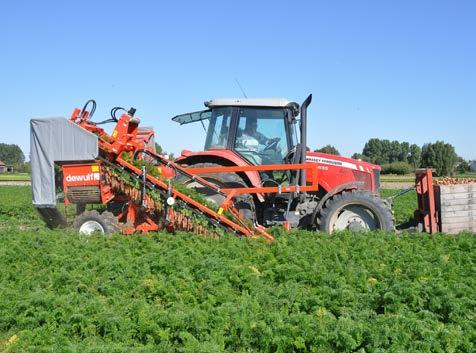
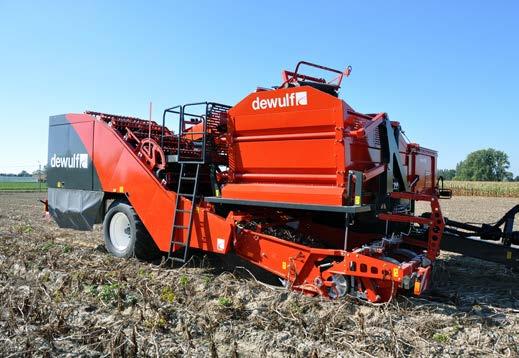


GRASSROOTS GROWING IN SOUTHLAND
Small horticulture operations are cropping up around Southland as interest in buying local increases across the region.
HELENA O’NEILL takes a look at two small-scale growers near Invercargill.
Mike and Annette Trent have been running Greenyard Veges for 10 years on their 1.2-hectare block near Invercargill.

Annette says they started the business as a step towards semi-retirement, building on their passion for gardening.
“Both our parents were vegetable gardeners, so we’ve always had a vegetable garden for our own kids growing up. We got the opportunity to purchase the property next door which had a very large tunnel house. It’s not a very large tunnel house now as we’ve put up some bigger ones, but for us [starting out] it was huge,” she says.
“First off it was for family, so we could have fresh veges. Then it became something more than that,” Mike says.
Growing hydroponically really saved the business in the unusually hot summer this year
“One of the first crops I put in — I didn’t really know what I was doing on that scale — was lettuce. If you’ve ever seen what one thousand lettuces look like becoming ripe [for harvest] at the same time … it was great but it was horrendous. It dawned on me that I needed to look at what we were doing and how we were doing it.”
They did manage to sell the 1000 lettuce “at every A&P show and every market we could find”, Mark says, both laughing at the memory.
Annette says that while it was stressful selling so many lettuces at once, it was an excellent way to introduce themselves to their customer base.
“We definitely grow for our local Southland market here.”
The Trents aim to grow fresh produce by locals for locals, following organic principles while growing both in the ground and hydroponically.
“We pick ready-to-eat, spray-free vegetables for you to enjoy. Safe and healthy with all the goodness nature can offer and travelling a mere 32kms to get to you at our local farmers’ market every Sunday, or a pickup point in Invercargill during the week.”
They introduced hydroponic growing to their business because Mike was interested in the system.
WE PICK READY-TO-EAT, SPRAY-FREE VEGETABLES FOR YOU TO ENJOY. SAFE AND HEALTHY WITH ALL THE GOODNESS NATURE CAN OFFER AND TRAVELLING A MERE 32KMS TO GET TO YOU AT OUR LOCAL FARMERS’ MARKET EVERY SUNDAY
“We have a variety of hydroponic methods that we use for different plants, we’re primarily growing hydroponically now … we do grow capsicums and tomatoes in the soil.”
Growing in the deep south offers its own challenges with a harsher winter, Annette says.

“We plant with the frost in mind, so we plant a little later with our tomatoes and the watercress we don’t start until the last frosts have been. The weather has been super challenging, with a horrendous summer this year … the plants were reacting quite differently. They were just getting too hot. We put up extra shade this year, but we might have to put up more shade next season.”
Growing hydroponically really saved the business in the unusually hot summer this year, she says. It uses less water and helps alleviate the drought conditions’ effects on their crops.

Mike still works full-time at Environment Southland as their principal advisor for Māori but enjoys producing fresh fruit and vegetables on their lifestyle block.
“I get a kick out of growing things that you can eat. It’s part of my relaxation,” Mike says.
There’s a great deal of satisfaction in growing your own food, Annette adds.
“We have a community growers’ stall there too so that some growers who can’t make it to the market can still sell their produce there. It’s really about trying to connect local consumers with their local growers. We have to be able to support our small growers here in Southland.”
She says initiatives like The Murihiku Kai Collective also help support small-scale growers. The aim of the collective is to work collaboratively to strengthen food security and sovereignty in Southland, enabling Southlanders to have the capability to produce and access good food. Good food is defined as food and beverages that are affordable, nourishing, appetising, sustainable, locally produced and culturally appropriate.
Annette also chairs the Southern Farmers’ Market which aims to rebuild the relationship between the local growers and the community....we’re primarily growing hydroponically now … we do grow capsicums and tomatoes in the soilAnnette and Mike Trent grow a range of produce including tomatoes
The Murihiku Kai Collective is made up of Healthy Families Invercargill, WellSouth Primary Health Network, South Coast Environment Society, Southern Farmers’ Market, Koha Kai, Spirit Army, WasteNet Southland, Invercargill City Council Parks and Recreation team, KiwiHarvest, Riverton Food Co-Op, Longwood Loop and South Alive. Honesty runs deep in Southlanders, with figures usually balancing at Greenyard Veges’ roadside stall on the Southern Scenic Route between Invercargill and the Catlins.
“From time to time if we’re a bit short on payment then there will be a bit extra the following day,” Annette says. Greenyard Veges has teamed up with other local growers to help stock their roadside stall. One of those businesses is Poppy’s Farm, run by Mark Hancock and Catherine Reed.
Poppy’s Farm is just over a year old, with the operation a far cry from Mark and Catherine’s long-term bakery business in the Far North. Catherine says the couple relishes the lifestyle and challenges offered by horticulture.


“The day we got the property here in Southland, Mark got the tractor and got it ploughed up before we did anything.”
Coming from the Far North, with a short stint on the West Coast before moving to Southland, Catherine has been “blown away” by the friendliness and helpful nature of Southlanders.
The couple is a big believer in farmers’ markets and encourages growers to support their local market
“We’ve got such great neighbours … I don’t think we’ve ever come across anyone as friendly as this. We don’t know the temperatures and climate; we have to learn that but they’re willing to help us. We did have an amazing summer — a hot, beautiful summer.”
MARK AND CATHRINE HAVE A 29-HA BLOCK, GRAZING SOME BEEF CATTLE AND SOME SHEEP, GROWING CROPS ON ABOUT 1HA
“I’m not used to having the four seasons. I’m from the Far North and you definitely don’t get autumn there,” she says.
The couple has a 29-ha block, grazing some beef cattle and some sheep, growing crops on about 1ha. Mark says they set up their market garden to supply their neighbours and rural community.
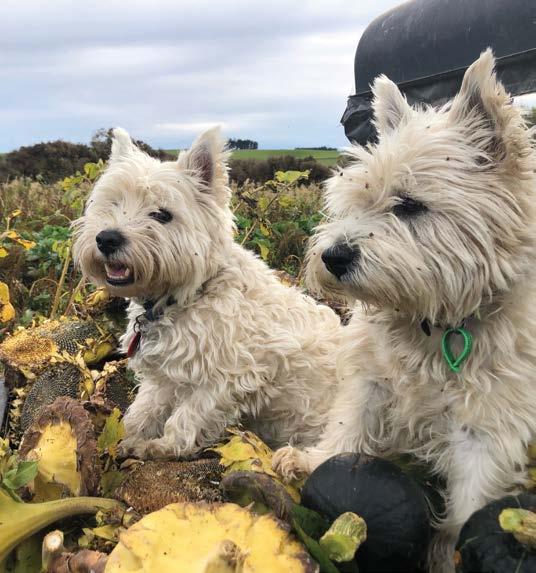
“Everything we’ve been told we can’t grow, we do. We started growing produce to try and support the local community the same as we did with our last bakery. We had a wood-fired brick oven in a remote area of Northland that we set up for the community. Here we have a lot of farmers … who don’t have time to run a garden because they’re so busy farming.”
The couple is a big believer in farmers’ markets and encourages growers to support their local market.
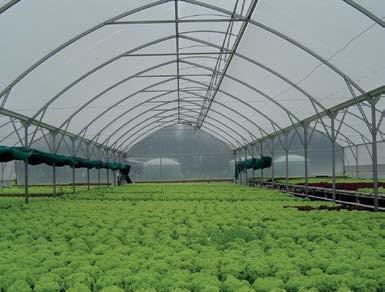

“If we got another three or four big growers at the farmers’ market, they’re not actually competition. The worst thing is when people go to the market and can’t find what they want and don’t return,” Mark says.

WET PUKEKOHE STRUGGLES TO BOOST SUPPLY
Further bad weather on the East Coast which affected vegetable supplies saw other growing areas called on to boost their supplies. But Pukekohe and Matamata growers had problems of their own with showers continuing to hamper harvesting and sowing. And storage issues caused by rain earlier in the year are now being fully realised.

On 26 June Countdown emailed customers saying that due to road closures key produce suppliers faced difficulties getting fruit and vegetables from Tairāwhiti and Hawke’s Bay to market. Bagged salads, lettuce, broccoli, and mandarins would be in limited supply at its stores for a few days.
LeaderBrand’s chief executive, Richard Burke, praised the company for being proactive and keeping shoppers informed. The East Coast has specific infrastructure issues which needed to be addressed such as rivers and drains flooding and roading repairs, he says. But every growing area in the country had suffered problems due to wet weather apart from those in the South Island, which were able to help out with supply shortages further north, although there were extra costs and some problems in getting produce across Cook Strait.
Broccoli supply was the most consistent with prices more competitive but there was some disruption in supply of salad leaves and spinach with a drop off in availability.
“With lettuce there were more shortages.” That meant prices continued to be strong but cabbages, used in LeaderBrand’s range of slaws, were plentiful. While growers could make use of properties in different areas to keep the flow of vegetables to market consistent, it wasn’t really possible to build in more supply capacity to use to fill any unexpected gaps.
“If you have wet weather you’re just going to lose more,” he says. “Our role is to manage risk.”
LeaderBrand was putting plans in place to spread that risk with some salad greens now coming out of its new covered growing area and a range of different vegetable varieties being grown.
“It’s not about fixing the past but investing in the future,” he says. “It’s been a tough 18 months but at the end of the day growers have got a job to do. We’re not just planting in hope.”
President of the Pukekohe Vegetable Growers Association (PVGA), Kirit Makan, says local growers tried to fill gaps created by the disruption in East Coast vegetable supplies where they could.
“Where they can, they will,” he says. “But it’s still relatively tight because it’s been quite wet. It’s been really challenging.”
Planting of brassicas and lettuce was being held up which was likely to have an effect on supply later on, and crops already in the ground were having their growth slowed by sitting in wet soil. Planting of potatoes and onions was “spasmodic” as growers tried to make the most of any windows of fine weather. There were also widespread quality issues with vegetables held in storage.
“Everyone’s in the same boat.”
You wake up in the morning and it’s raining
Pukekohe grower, Bharat Bhana, says rainfall up to June last year was 489 millimetres but this year it’s been over double that at 1009mm.
“We’ve had problems all the way through,” he says. “You wake up in the morning and it’s raining.”
Potatoes, carrots and onion crops were all affected. “It’s been a real testing time for us this year,” he says. “The ground is just saturated. It can be dry but then with 20mm of rainfall it’s full again and up to capacity.”
This created problems getting on the ground unless it had been ridged up earlier in March when drier weather allowed. Higher wastage rates for vegetables held in storage meant up to half their pumpkins harvested in
May were showing signs of rot and so unsaleable, with that percentage increasing as the season’s gone on.
“There’s not much anyone can do.”
He puts potato losses at 10 percent from crops which sat in water sometimes up to the top layer of the soil but where no damage was immediately visible in the field. And with some onion crops, despite the extra time taken grading to remove any with quality problems, in some cases it would have been better to dump them despite getting better prices.
“Your first cost is your worst cost.”
While he put losses on earlier season export onion crops at around 10 percent those now being sent to the local market were showing losses up to 30 percent due to rot.
“The public has to get used to the price of vegetables,” he says. “They can’t say they still want to buy lettuces for 99 cents.”
The public has to get used to the price of vegetables
And while prices might go down when more normal growing conditions return he believes they won’t drop to what they previously were due to input costs and Government regulation increasing as well growing land continuing to be sold for new housing.

TECHNICAL
THE LATEST INNOVATIONS AND IMPROVEMENTS
 43 WET WEATHER
Photo by Trefor Ward
43 WET WEATHER
Photo by Trefor Ward
2023 SO FAR: NEW ZEALAND’S RECORD-BREAKING WEATHER
NIWA analysis last month revealed that, at only halfway through the year, some parts of New Zealand had already recorded more than a year’s worth of rain.
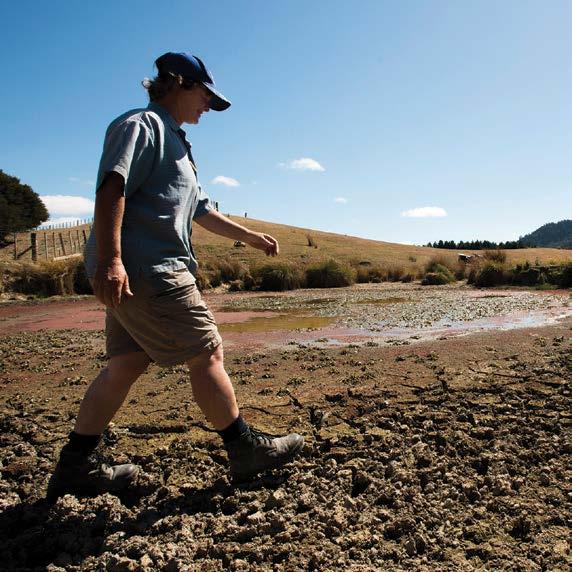
The first half of the year was the wettest on record for several areas in the northern and eastern North Island.
For many, the results probably won’t be a surprise. Those living in Northland, Auckland, the Coromandel Peninsula, Gisborne, and Hawke’s Bay have dealt with a constant barrage of sub-tropical lows, atmospheric rivers and ex-tropical cyclones, which caused copious amounts of rainfall. It has been quite relentless.
On the rainiest end of the spectrum, Kaikohe in Northland received over 130 percent of its normal annual rainfall from January-June. On the driest end of the spectrum, Waimate in South Canterbury received just 33 percent of its normal annual rainfall from January-June.

In terms of temperature, January-June 2023 was 1.1˚C above average, according to NIWA’s seven station temperature series which began in 1909. This is the second warmest such period on record. Only 2016 had a warmer January-June.
What was behind the wet and warm?
La Niña: Even though it officially ended earlier in the year, the lingering influence of La Niña contributed to an air pressure pattern that brought more sub-tropical, northeasterly winds, atmospheric rivers, and increased the risk for ex-tropical cyclones.
Southern Annular Mode: Persistent “blocking” high pressure near the South Island enabled rain-bearing weather systems to linger for long periods of time, sometimes affecting the same regions day after day.
Marine heatwaves: Frequent air flows from the north-east, reduced westerly winds, high pressure near the South Island, and climate change enabled this driver to bring warmer temperatures and increased moisture availability to the New Zealand region.
Climate change: The impact of climate change left a strong imprint on the record warmth and exacerbated the extreme rainfall events during the first half of the year.
JANUARY-JUNE
2023 WAS 1.1˚C ABOVE AVERAGE, ACCORDING TO NIWA’S SEVEN STATION TEMPERATURE SERIES
WHICH BEGAN IN 1909. THIS IS THE SECOND WARMEST SUCH PERIOD ON RECORD.
ONLY 2016 HAD A WARMER
JANUARY-JUNE
NIWA SEASONAL CLIMATE OUTLOOKS
Predictions of temperature, rainfall, soil moisture and river flows.
niwa.co.nz/outlook
Ben Noll : National Institute of Water & Atmospheric Research (NIWA)Record rainfall in the first half of 2023
This table shows the 21 locations* across seven different regions that experienced a record wet January-June.
Northland January-June rainfall (mm) Year records started
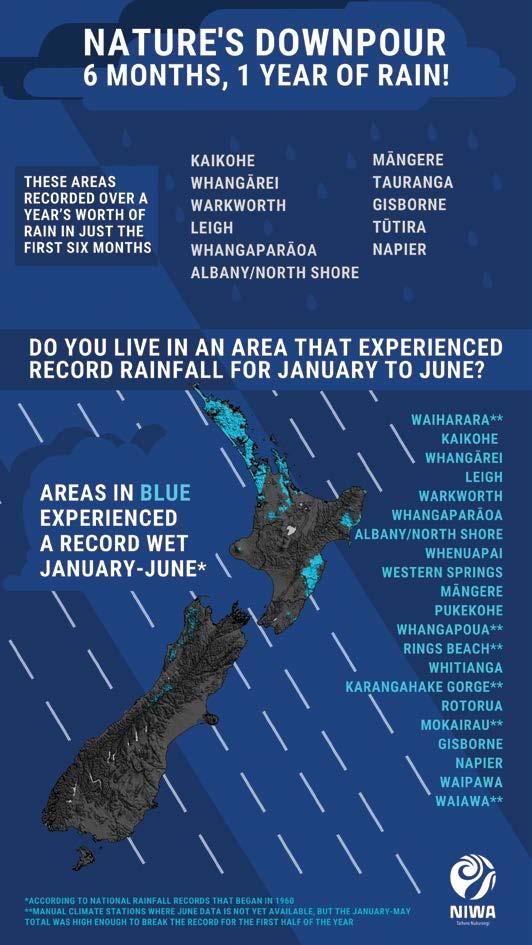
Waiharara** 973 mm 1956
Kaikohe 2140 mm 1956
Whangārei 1526 mm 1943
Auckland January-June rainfall (mm) Year records started
Leigh 1234 mm 1967
Warkworth 1525 mm 1972
Whangaparāoa 1114 mm 1946
Albany/North Shore 1319 mm 1966
Whenuapai 1443 mm 1943
Western Springs 1280 mm 1948
Māngere 1152 mm 1959
Pukekohe 923 mm 1944
Waikato January-June rainfall (mm) Year records started Whangapoua** 1552 mm 1999
Rings Beach** 1400 mm 1986
Whitianga 1661 mm 1961
Karangahake Gorge** 1451 mm 1981
Bay of Plenty
January-June rainfall (mm) Year records started
Rotorua 1435 mm 1963
Gisborne
January-June rainfall (mm) Year records started
Mokairau** 1196 mm 1947
*Climate stations or climate station groupings in operation before the year 2000

**Manual climate stations where June data was not available at the time of writing, but the January-May total was high enough to break the record for the first half of the year.
Looking ahead: outlook to September
El Niño is emerging in the tropical Pacific and is expected to bring notably different weather patterns to the country during the back half of the year compared to the first.
With a developing El Niño, air pressure is forecast to be above normal over the Tasman Sea, leading to more southwesterly quarter winds than normal across the country for the season as a whole. Historically, this has increased the chance for drier-than-normal conditions in eastern areas of the country and caused more rain in the west.
The developing El Niño is expected to result in a lower likelihood of tropical moisture plumes, such as those that frequently affected the country during the first half of this year.
Temperatures are about equally likely to be near average or above average in all regions. The potential easing of above average SSTs and a reduction in northerly air flows
are expected to make for a season that has less frequent spells of above average temperatures. Short-but-sharp cold snaps are also likely.

Soil moisture levels are most likely to be near normal in all regions.
In summary, a change in the climate driver means a change in the wind, and ultimately, a likely change in rainfall patterns. The weather is likely to be quite different to what we’ve been living through in recent times.


PRODUCT GROUPS
ALL THE LATEST NEWS FROM YOUR PRODUCT GROUPS
52 POTATOES NZ CONFERENCE

WHAT WE CAN LEARN FROM AUSTRALIA’S GREENHOUSE GROWERS

I’d like to thank the Tomatoes NZ board for supporting my participation in the Protected Cropping Australia (PCA) conference in Brisbane. PCA represents commercial hydroponic and greenhouse growers Australia wide.


It was my first horticulture conference and has set the bar really high with excellent presenters, real experts in their field, great exhibitors who were willing to share their knowledge (without it feeling like they were trying to push a product), great venue and opportunities to network. There was a choice of three presentations running concurrently on both days, meaning it wasn’t always easy to choose which to attend!
Some of my initial takeaways from the conference were that the federal and state governments in Australia do a lot more to support growers than the New Zealand government does. This has led to matched funding for so many different research streams. There were at least four universities present – all running multiple research projects in horticulture. They also subsidise undergraduate horticulture studies and offer a tax rebate for businesses doing research and development projects. There were five students given three minutes each to present their research projects and all were fascinating.
In short there’s a real buzz and thirst for looking to the future rather than waiting for a disaster to happen and needing to be reactive.
Dinah Cohen : TomatoesNZ Inc business managerI was lucky enough to hear and then talk to some of the team of researchers from the Centre for Horticultural Science at Queensland Alliance for Agriculture and Food Innovation (QAAFI) at the University of Queensland. They are looking into the use of double-stranded RNA for protection against pathogens and whitefly. This is an interesting piece of work that has huge potential for greenhouse growers on this side of the ditch as well.
There’s
buzz and
reactive
On the last day I joined a tour to the QAAFI labs at the University of Queensland. We had a look at where they do tissue culture research with 10 PhD students and around six post-doctoral research assistants. The work they do is incredible – creating millions of seedlings from tiny amounts of tissue culture (a 0.1mm piece of avocado tissue culture produces around 500 avocado trees that are all genetically identical and fungal and disease free). The labs are sterile to hospital level and the seedlings are propagated in vertical farms to accelerate growth. This has potential for any crop.
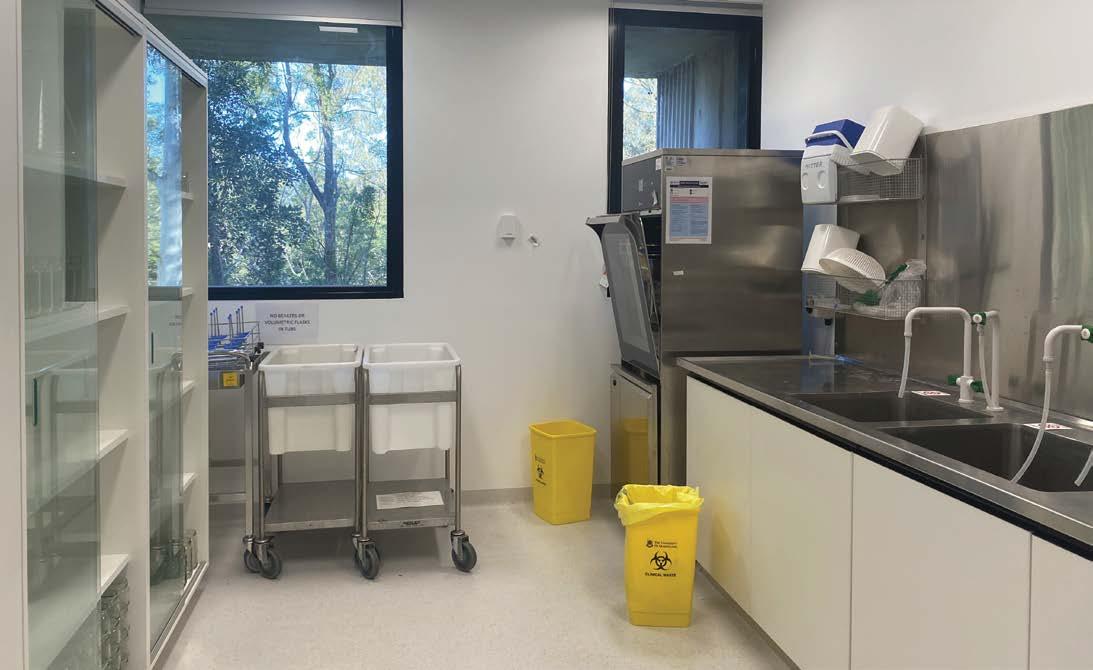 The labs at the Centre for Horticultural Science at the University of Queensland
The labs at the Centre for Horticultural Science at the University of Queensland
a real
thirst for looking to the future rather than waiting for a disaster to happen and needing to be
VERTICAL FARMING
WILL BE PART OF THE SOLUTION ALONG WITH
GREENHOUSES TO COMBAT CLIMATE CHANGE, INCREASING TEMPERATURES AND EXTREME WEATHER EVENTS
There were some interesting presentations on vertical farming including one by sustainability strategist and influencer Henry Gordon-Smith. The view is that vertical farming will be part of the solution along with greenhouses to combat climate change, increasing temperatures and extreme weather events. Australia is heating up faster than New Zealand, which could be a real opportunity for New Zealand to get ahead of the game to feed the growing world population (set to rise to 9 billion by 2050 from the current 7 billion).
I was interested in a new piece of equipment by Optimal Group Australia that is being installed in some large greenhouse businesses at the moment that allows fully circular production of heating, opportunities to make money (by selling the biochar created), production of CO2 for use within the greenhouse and also electricity meaning the grower is not reliant on grid upgrades. While the Australian government haven’t imposed the ’stick’ of a carbon tax, they do offer a ’carrot’ with helping to fund such decarbonising equipment.

I was interested in the presentations on Integrated Pest Management (which one speaker said should really stand for Intelligent Pest Management). The beneficial insects might vary in Australia but the same principles still apply – although it does seem like the uptake of biological control agents is not as widespread among Australian growers as it is in New Zealand. There was an example of a grower spraying 115 different chemicals in 74 applications over an 8-week period and still had the same or worse pest issue at the end of the time period. A grower that we visited as part of a farm tour said they didn’t use any beneficials and instead used chemical sprays regularly as a preventative measure. I could picture our A Lighter Touch/Bioforce project team shaking their heads at this!
Share your thoughts and feedback with Dinah at:
dinah.cohen@hortnz.co.nz
The labs at the Centre for Horticultural Science at the University of QueenslandSome of my initial takeaways from the conference were that the federal and state governments in Australia do a lot more to support growers than the New Zealand government does
USING NANOBUBBLES TO INCREASE PLANT YIELD BY UP TO 35 PERCENT

A nanobubble enriched water trial at Clearwater Gardens organised with support from Vegetables New Zealand Inc has demonstrated a 35 percent increase in plant yields. Dale Smith at NanoB ran the Case Study at grower Robert Cole’s leafy greens hydroponics farm in Christchurch. We invited Dale to share the results with attendees at the Horticulture Conference week earlier this month.
Impressively, Dale showed how plant yields increased as much as 35 percent and confirmed the overseas growers’ results using nanobubbles.
Overseas field results are also showing yield increases between 12 to 40 percent in a variety of other crops like almonds, avocados, blueberries, cherries, corn, cucumbers, flowers, leafy greens, nut crops, peppers, strawberries and tomatoes.

Nanobubbles improve soil and nutrient transpiration within the plants leaves
Nanobubbles exist in nature and are tiny gas-filled bubbles measuring less than 100 nanometers in diameter. They have great potential to increase plant yields.
 Daniel Sutton : Vegetables New Zealand Inc research, development & extension manager
Daniel Sutton : Vegetables New Zealand Inc research, development & extension manager
As Dale explained, the key benefits of using nanobubbles and the mechanisms behind their effectiveness are:
1. Enhanced oxygen supply: They are neutrally buoyant so stay in solution and with their high oxygen content can deliver oxygen directly to the root zone thereby promoting positive aerobic conditions, preventing oxygen deficiency, and supporting the growth of healthy roots, leading to improved plant vigour and productivity.
2. Increased nutrient uptake:
Their nano size gives them a very large surface area to volume and they are negatively charged, and thus increase the solubility and mobility of nutrients in the soil/water, allowing for easier absorption by the plants and improved nutrient utilisation efficiency, ensuring that plants receive an optimal supply of essential elements for growth.
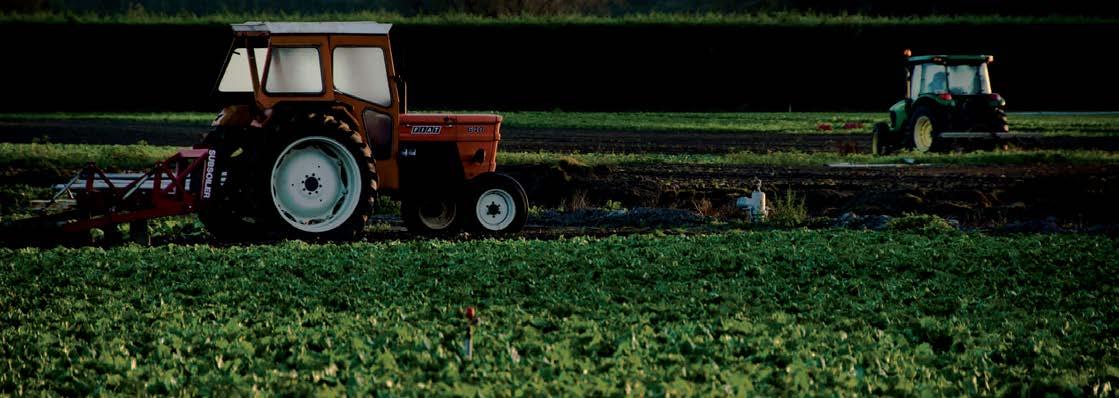
3. Better water management:
Nanobubbles improve soil and nutrient transpiration within the plant’s leaves by causing the water to act as a surfactant, increasing the wetting ability of water to infiltrate soil more easily and, ensuring more efficient water distribution to the root zone and uptake by the roots and then through the plant stem and leaves. This is particularly beneficial in soils with poor water-holding capacity or uneven moisture distribution.
4. Stimulated photosynthesis: Nanobubbles have been shown to enhance photosynthetic activity in plants resulting in increased energy production and improved carbon assimilation, leading to enhanced plant growth and yield.
5. Disease suppression and stress tolerance: Nanobubbles possess antimicrobial properties when the bubble finally implodes creating hydroxyl radicals and can help suppress plant pathogens, bio film reduction and thus contribute to disease management and reduce the reliance on chemical pesticides.
500-5000 nm (0.5-5 µm)
1000-50.00 nm (1-50 µm) Micro bubble
10.00-30.000 nm (10-30 µm) Plant cell
8.000 nm (8 µm)
cell
If you would like to learn how nanobubble enriched water can help your business, contact:
EXCITING LINEUP OF SPEAKERS AT THE POTATOES NZ CONFERENCE!
We are thrilled to bring you exciting news about the upcoming Potatoes NZ Conference, set to be a significant event for the potato industry. Taking place on 22 August at Te Pae in Christchurch, this conference promises to be a gathering of industry leaders and professionals, offering discussions on the latest trends, innovations, and opportunities in the world of potatoes.

The conference website, potatoesnzconference.nz, provides comprehensive information about the event, including the agenda, registration, accommodation, and venue details. We highly encourage you to visit the website for a complete overview of what awaits you.

One of the highlights of this conference is the impressive lineup of speakers who will be sharing their insights and expertise. Allow us to introduce you to three notable speakers you won’t want to miss:
Darren Long, a recognised leader in cover cropping and biofumigation, brings over 20 years of experience as a Tasmanian potato grower. Co-founder of Soil First Tasmania, Darren has successfully implemented innovative practices on his family-owned farm, inspiring fellow farmers to adopt sustainable farming techniques. His session on soil resilience in an ever-changing climate will be enlightening for all attendees.
Cameron Bagrie, an esteemed NZ economist, will provide valuable insights into current market conditions and their potential impact on the potato industry. With his deep understanding of economic trends and their implications, Cameron’s session promises to offer a broader context for strategic decision-making in the sector. Get ready for his candid opinions that will challenge and provoke thought.
 Renu Ryder : Potatoes NZ communications & engagement officer
Cameron Bagrie
Darren Long
Renu Ryder : Potatoes NZ communications & engagement officer
Cameron Bagrie
Darren Long
Hamish McKay, the host of Mediaworks flagship agribusiness REX on Magic Radio, brings a unique perspective to the conference. With his strong ties to the Manawatu region, Hamish expertly bridges the urban-rural divide on his radio show. Drawing from his extensive career in rugby, television presenting, and commentary, Hamish will share his captivating stories with us. Prepare for an engaging and memorable session.
These speakers, among many others, will provide thought-provoking presentations and commentary, and a chance for us to gain new perspectives within the potato community.
We encourage you to secure your spot at the PNZ Conference as soon as possible. Registering now ensures that you won’t miss out on this exceptional learning and networking experience. We eagerly look forward to welcoming you at the Potatoes NZ Conference and experiencing an unforgettable event together!
For more details and to register, please visit our conference website: potatoesnzconference.nz
STUDY INDICATES DIABETICS CAN CONSUME MORE POTATOES

Potatoes, often given a bad rap for their carbohydrate content, have long been misunderstood, especially when it comes to their suitability for individuals with diabetes. However, recent observational research* of over 2000 participants has shed light on the potential health benefits of potatoes for diabetics. Far from being a dietary villain, potatoes can actually play a valuable role in managing blood sugar levels and supporting overall health.
One of the main concerns for diabetics is the impact of food on blood sugar levels. The glycemic index (GI) is a measure of how quickly a food raises blood sugar levels. Contrary to popular belief, potatoes have a range of glycemic indices, with certain varieties, such as sweet potatoes and boiled new potatoes, having a lower GI. This means they have a slower and more gradual effect on blood sugar levels, making them a favourable choice for diabetics.
Potatoes, particularly when consumed with their skin, are a rich source of dietary fibre. Including fibre-rich potatoes in a balanced meal can help diabetics maintain stable blood sugar levels and promote digestive health.
By debunking the myth that potatoes are off-limits for diabetics, we can encourage a more nuanced understanding of this versatile and nutritious vegetable. With the right knowledge and moderation, potatoes can be a valuable part of a well-rounded diet that supports the health and well-being of individuals with diabetes.
The key lies in informed choices, portion control, and maintaining a balanced and varied diet for optimal health management.
* Journal of Nutritional Science, Volume 11, 2022, e73
POTATO OF THE MONTH: LUCERA
High setting, bright skinned specialty baby potato

STRENGTHENING TIES BETWEEN OUR ONION SECTOR AND INDONESIA
On 7 June Onions New Zealand signed a cooperation agreement with the Ministry of Agriculture in Indonesia. This represents the first steps toward a strengthened relationship directly between the onion sector and the Indonesian government.


Onions New Zealand has been working to develop a cooperation agreement for the past few years with the intention of supporting trade relationships and giving back to Indonesian farmers and growers. Onions New Zealand welcomes long-term strategic partnerships and believes that there should be mutual benefit and trust, explains Kazi Talaska, market access and development manager. “Relationships are very important for our sector and New Zealand as a small trading nation,” she says. “Conversations, connections, and dialogue equip us to discuss and face issues collectively.”
The hope is that this cooperation agreement and the relationships developed will support further work with the Indonesian Ministry of Agriculture and the New Zealand horticulture sector. Indonesia is one of the largest democracies and a key player in the Asia-Pacific region on the way to become one of the world’s top 10 largest economies. With a population of 270 million people, Indonesia is a substantial market on our doorstep. The New Zealand onion sector currently exports approximately 35,000 tonnes at a value of NZD $30 million every year; making Indonesia one of the biggest markets, alongside those in the EU.
“Anything we can do to support this important trading relationship for our sector, should be explored,” Kazi says. Although onion growers from New Zealand have a long history of exporting to the EU, over the last 10-20 years, the Southeast Asia market has grown substantially, providing improved payment terms, longer export window and alternatives to an over-reliance on the EU.
“Over the years New Zealand has faced some non-tariff barriers with Indonesia. Whilst we typically push for rules-based trade, we recognise that the Western based perception of how trade takes place is at times limited/ challenged. We (Onions New Zealand) recognise that not all countries operate the same and we need to adapt our strategies and ways of doing business accordingly.”
The agreement was signed with Badan Standardisasi Intrumen Pertanian, directly translating to the Bureau of Standardisation within the Ministry of Agriculture. The scope will see the New Zealand onion sector support three years of research and extension for Indonesian growers, particularly for shallots; a strategic commodity that is widely grown, consumed, and has a high economic value for Indonesia.


Annually, the cooperation agreement sees approximately NZD $30,000 of investment, which is partly funded by the Ministry for Primary Industries’ Sustainable Food and Fibre Futures (SFF Futures) .
The activities planned over the next three years include inventory of pest and disease data, verification of fertiliser standards in different regions, and application of control standards for extension on demonstration plots.
A steering group has been established to progress the cooperation. The steering group consists of Kazi Talaska from Onions New Zealand, the director general Prof. Dr. Fadjry Djufry, director of horticulture Dr. Husnain, MP., M. Sc, as well as supporting staff.
Additionally, the scope allows for exchange of technical expertise between countries where required. There is an acknowledgement that around the topic of pests and diseases there is much to learn on both sides for effective control.
Kazi Talaska, market access and development manager at Onions New Zealand Inc at the signing with Dr. Fadjry Djufry Director General of IAARD (Indonesian Agency for Agricultural Research and Development)NEW TRIALS: BIOLOGICAL BOOSTS CARROT AND ONION YIELDS
Two recent Biostart Mycorrcin trials in commercial carrot and onion crops have resulted in increased yields. The carrot crop had higher seedling survival, more first-grade carrots, and fewer rejects, which led to improved marketable carrot yield and profitability. The onion crop also had higher seedling survival while maintaining the same mean bulb weights.
Biostart Mycorrcin is a soil biostimulant that is designed to activate beneficial soil microbes, which stimulate healthy root growth and development leading to higher nutrient uptake, faster crop establishment and greater yield in crops.
The carrot trial was run on a commercial crop of Soprano variety carrots in Ohakune in 2022. The seed was sown in 1.72-metre beds with four plant rows per bed at 1.5 million seeds/ha. The Biostart treated beds received 6 l/ha of Mycorrcin applied just after sowing.



At harvest the Biostart treated plots had 15 percent more carrots, indicating better seedling survival. This higher carrot density in the beds produced more uniform sized carrots which increased the yield of first-grade carrots by 17 percent (22 T/ha) and reduced the yield of XL grade carrots (-3.3 T/ha). Overall the Biostart treated plots had a 58 percent less reject carrots harvested (-11.7 T/ha), which contributed to the higher marketable yield.
The application of Biostart Mycorrcin statistically increased the marketable yield of carrots by 13 percent (18 T/ha) from 147 T/ha to 165 T/ha. This was achieved through an increase in seedling survival, which led to greater carrot uniformity, and through reducing the volume of reject carrots.
The onion trial was run in 2022-23 in a commercial onion crop in the Hawke’s Bay. The Biostart treated beds received 3 x 5 l/ha of Mycorrcin, one after sowing, again at flagleaf and a further application at bulb formation.
The application of the Biostart programme increased the survival of the onion seedlings by 12.7 percent which carried through to harvest as an increased yield of 12.7 percent or 7.5 T/ha with both treated and untreated bulbs averaging 125 grams each. The increase in yield while having the same bulb sizes was therefore entirely due to increasing seedling survival rate.
These new results show that using the Biostart biostimulant Mycorrcin is useful for improving yield quality and quantity in both carrots and onion crops.
For more information visit: www.biostart.co.nz or contact Biostart on 0800 116 229

SAVING OUR SOILS
Many soils around New Zealand and Australia are becoming depleted by increasingly intensive horticulture practices. According to Allan Dean of Bactivate, an enlightened approach to ‘farming the soil’ can pay huge dividends in the short term, but even more so in the decades to come.
Allan considers a focus on building a healthy, living soil biology is the key to returning soils to productivity. “Regenerative farming utilising carefully researched soil microbes and a diversity of cover crop components is absolutely capable of returning our soils to optimum health and yields that had been considered impossible. The initial improvements will be detectable in months rather than in years.”
The concept of ‘farming the soil’ brings microbial density and earthworm counts into focus as indicators of healthy soil. Once thought of as ‘fringe’, significant producers are beginning to research approaches that balance regenerative farming and supplemental nutrients when needed to meet crop demands. “A middle ground approach is entirely feasible and needed to deliver food for a growing world population as well as financial sustainability for the grower,” says Allan. Bactivate’s biological inoculants are used to ‘help nature on its way’. With the right conditions, microbes will – once introduced – proliferate of their own accord. Biodiversity,
cover crops, minimum tillage, and microbe specific probiotics all play a part in optimising soil health and, as a consequence, crop yields.

A demonstration of the power of this approach was achieved in a potato trial over two seasons in the Meander Valley, Tasmania. Supported by McCain Foods, the trial summary can be found at bactivate.nz/research-potatoes/. Coincidentally, the weather in each of the two seasons was vastly different (2019 was an exceptionally dry season and 2020 very wet, with 50 percent above average rainfall). In both of these very different seasons, the Bactivate trial outperformed the state average yield, and year two showed an increase in yield of 48 percent over year one, which suggests as expected an improving trend in soil health and crop yield performance.

Anecdotally the harvester noticed an unusually large number of earthworms – a sign of soil health.
Further trials are underway lead by independent scientists due to these promising early trial results.
To find out more, visit: bactivate.nz
or contact Allan Dean: allan@bactivate.nz
027 535 6597
DON’T MISS OUT ON THE LATEST AGCHEM INFO
The latest edition of New Zealand’s legendary spray bible, the Novachem NZ Agrichemical Manual, will be available in August this year, so if your copy is looking a bit worse for wear after two years, it’s time to order an upgrade.
(HSNO) classifications and wording to internationally standardised language. The Globally Harmonised System (GHS) of classification and labelling of chemicals – is administered by the United Nations Economic Commission for Europe (UNECE) and was first introduced in 2002.
As well as many new product listings, the new edition updates existing products which include active ingredients that have been affected by regulatory review over the past two years, Peter says.
“As in previous editions, the trend continues with regards to withdrawal of older chemistry that presented a high risk to users and the environment being replaced by more target specific products, which are much safer to use and present a low risk of environmental harm.”
At about 800 pages, with 140 new listings, and 100 label amendments to existing listings, plus the latest regulatory amendments, the new manual is hardly a light read. But it remains a must for anyone in the industry who relies on gold-standard technical support for all things crop protection.
“Comprising a comprehensive alphabetical listing of products, active ingredients, crop and weed tables, weed and pest identification and much more in one single publication, it really is the definitive agrichemical guide and the only one you’ll ever need,” says editor Peter Holden. As always, it’s worth ordering early directly through the website (www.novachem.co.nz) as there will be an earlybird bonus offering.
Content wise, Holden says a major change this time around is to do with hazard codes and safety precautions, as our industry transitions from historical, New Zealandcentric Hazardous Substances and New Organisms

...the new edition updates existing products which include active ingredients that have been affected by regulatory review over the past two years
While many people still enjoy having a hard copy of the Novachem Agrichemical Manual, subscription to the online version has the additional benefit of providing product updates as they occur as well as being able to directly link to labels, safety information and further technical information from product suppliers.
For more information visit: www.novachem.co.nz

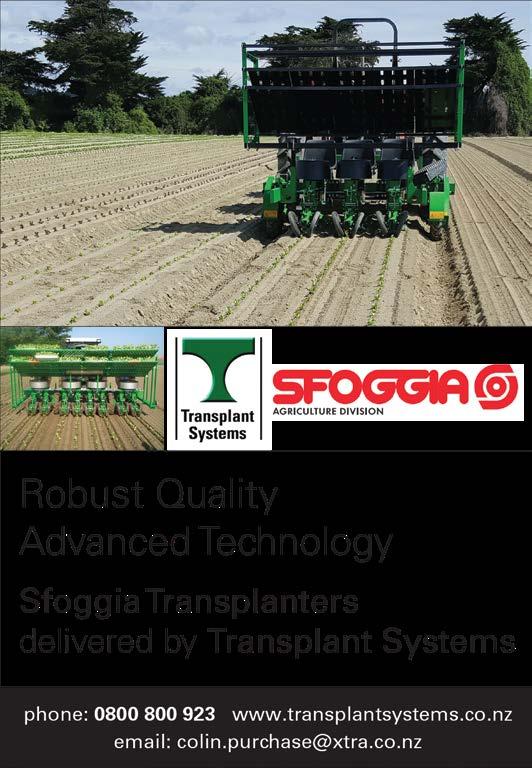
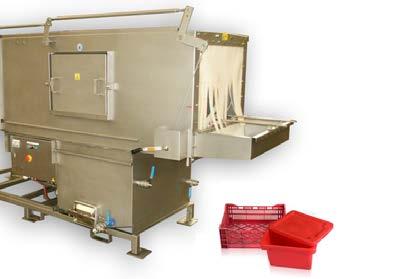




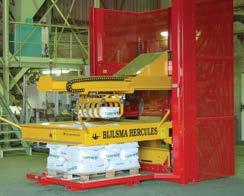


GETTING GROWERS ON THE AIR
Andrew Bristol : HortNZ communications manager


Nothing makes New Zealand consumers (and voters) appreciate their fruit and vegetable growers better than hearing from growers themselves. Every week national and local news outlets feature grower interviews, articles and news bulletins. Many are orchestrated behind the scenes by the Horticulture New Zealand communications manager, Andrew Bristol, working with other communications people employed throughout horticulture. We asked Andrew how it works.
HOW DO NEW ZEALAND MEDIA OUTLETS FIND GROWERS TO INTERVIEW?

“I am in close contact with all national and local media, as well as fellow communications people. There’s a lot of coordination – indeed, a reporter recently said to me ‘that’s what another communications manager said. Do you guys talk to each other?’ Being in close contact means that we can ensure that as an industry, our messaging is consistent and clear. It also means that we can find the type of grower that the media would like to talk to the most. Then we work with that grower on messaging.”
WHY ISN’T THERE BETTER UNDERSTANDING OF HORTICULTURE’S CLIMATE AND ECONOMIC CHALLENGES?
“Good question, but communications colleagues working in other industries and areas ask exactly the same question! Today’s reporters do not have a lot of time. They are under immense pressure to post the first story on the internet, almost before any announcement is made. That’s why it is important to build relationships with reporters, and be accessible and responsive. So in the little time they often have, they can write an accurate story.”
WE OFTEN HEAR FROM THE SAME GROWERS. SHOULDN’T OTHER GROWERS GET A CHANCE?
“The media has a habit of wanting to talk to a spokesperson they have used before, because it makes it easier for them. Also, not everyone wants to be interviewed, either because they don’t want the profile or the company for which they work doesn’t. That’s fair enough, particularly on controversial issues or where there could be a conflict of interest involved.”
IF GROWERS HAVE A STORY THAT SHOULD BE TOLD, SHOULD THEY CONTACT YOU?
“Absolutely. My colleagues and I are always on the look out for stories that show just how fantastic our growers and the produce that they grow are. While these stories won’t make the 6pm television news, you never know when they might be run, particularly by the smaller newspapers and magazines.”
Get the latest media coverage direct to your inbox with the HortNZ Weekly Briefing. Subscribe at: hortnz.co.nz
Growers are welcome to send their feedback and suggestions to Andrew at: andrew.bristol@hortnz.co.nz
Site specific advice on what options are available to you for reducing your energy usage along with a cost breakdown of each option.
Analysis on the options available for switching away from fossil fuels, includes initial capital costs, ongoing costs and how it can be done.
Advice on what support is available to help transition to low-emissions heat sources, through organisations such as EECA, energy and equipment suppliers, and finance providers.

85



1938-2023 YEARS
GREY PUMPKIN







Nelson, very early, bush type Sampson, main season, yield with long storage
Iron Lady, main season, great storage, new intro
BUTTERNUT

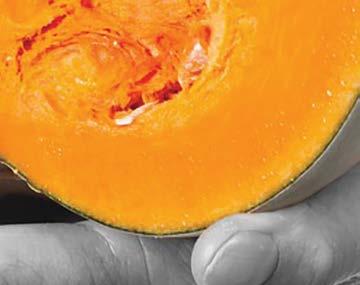



Tiana, smaller, earlier, and bountiful, Waltham type Havana, larger fruiting, high yield, Waltham type

